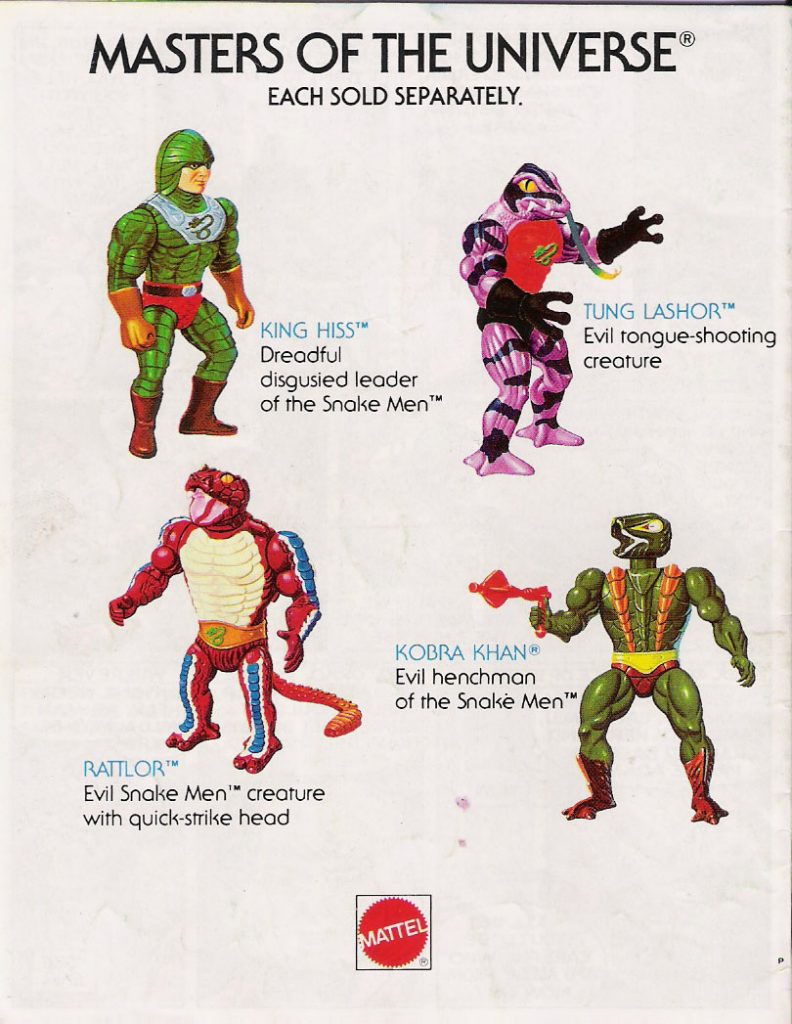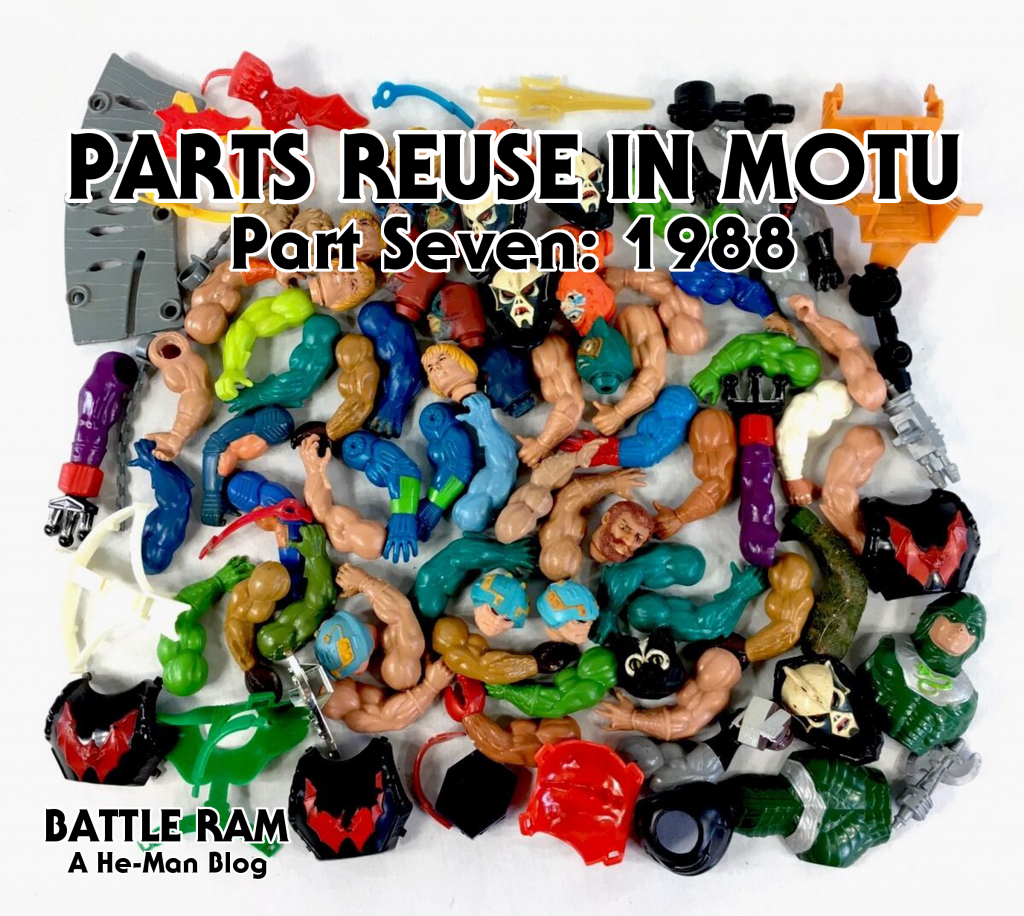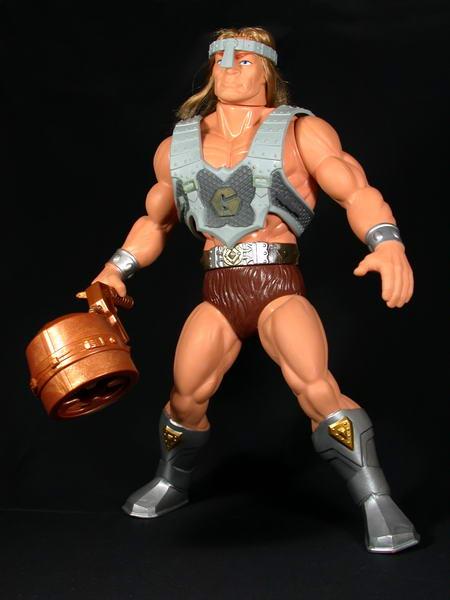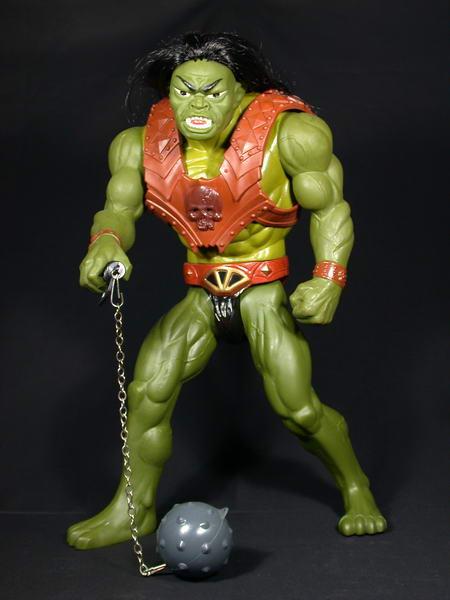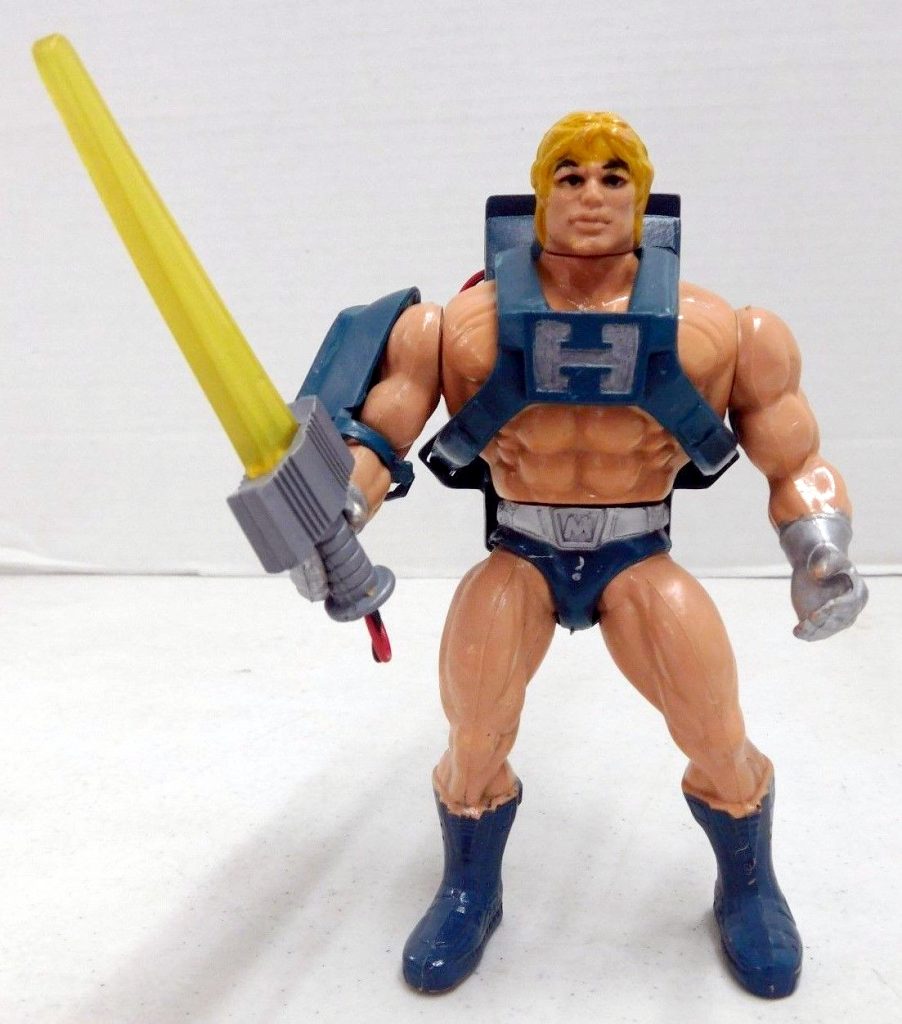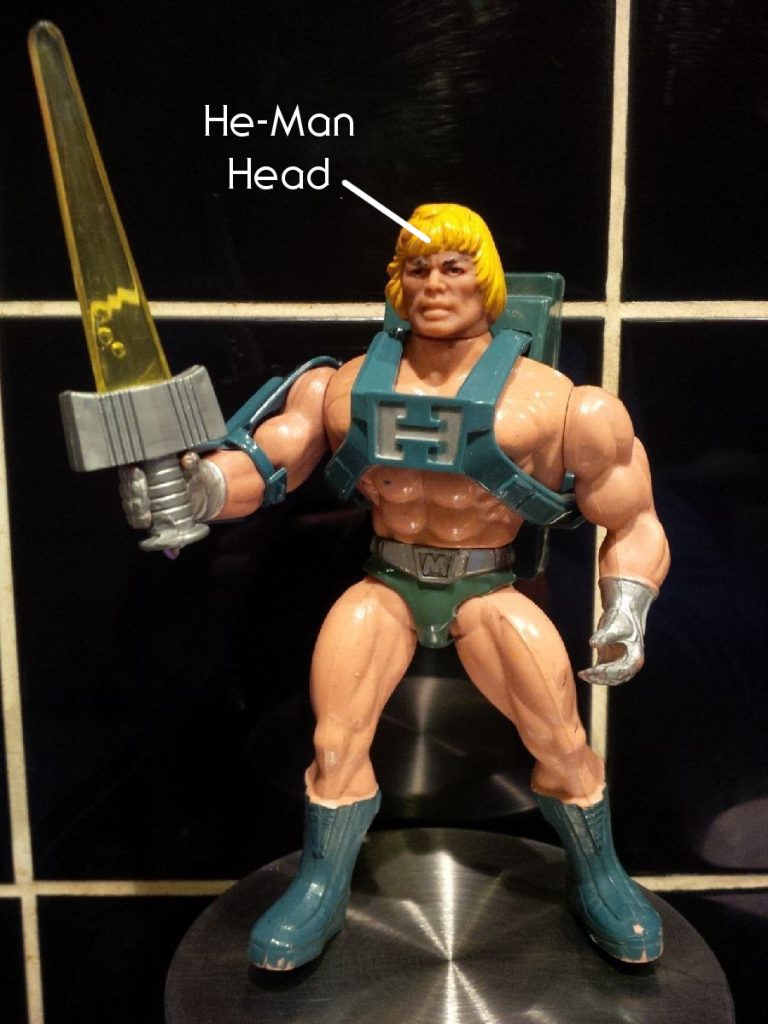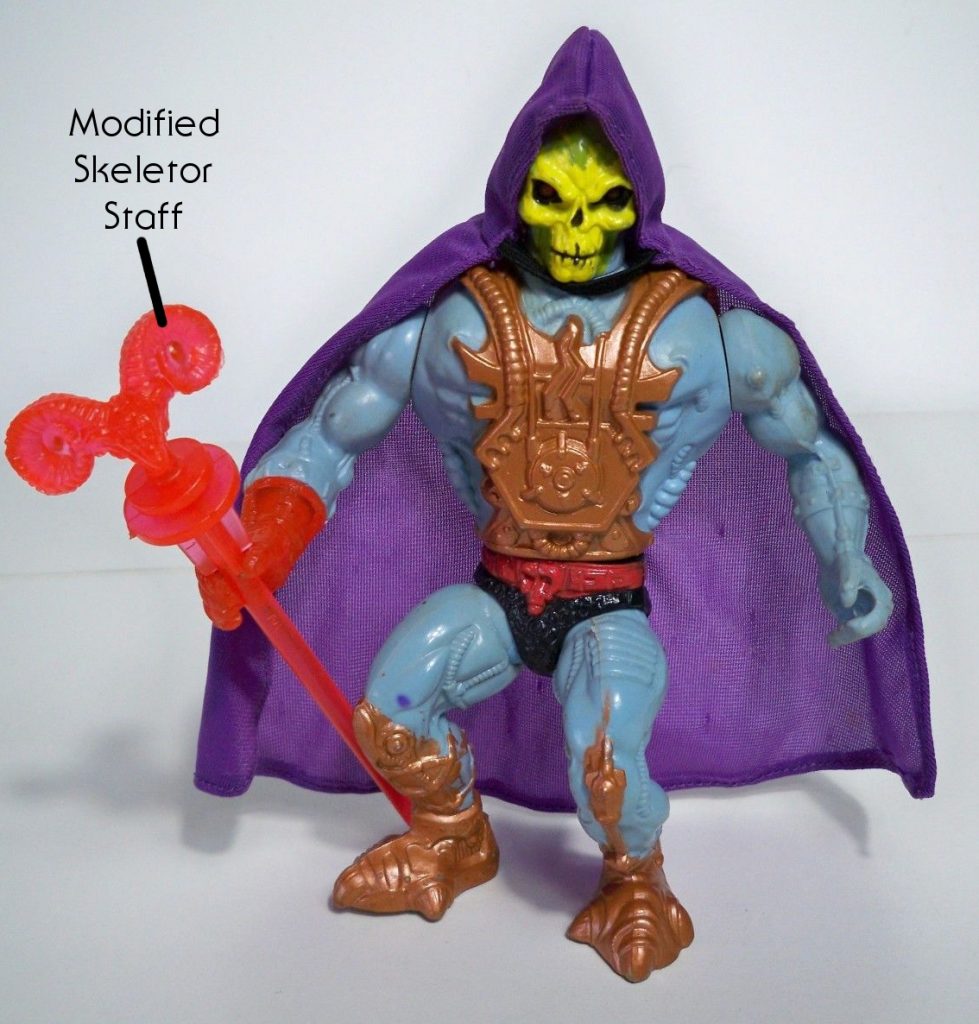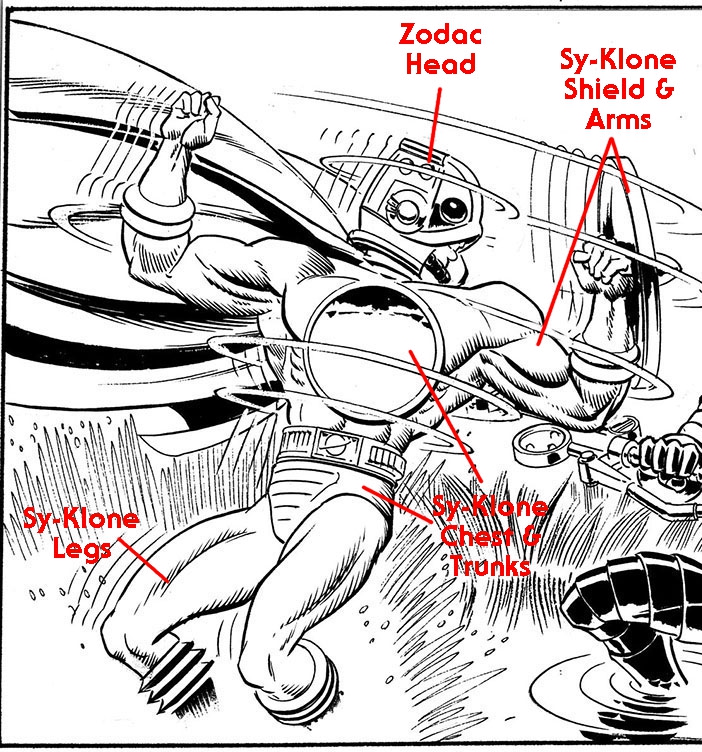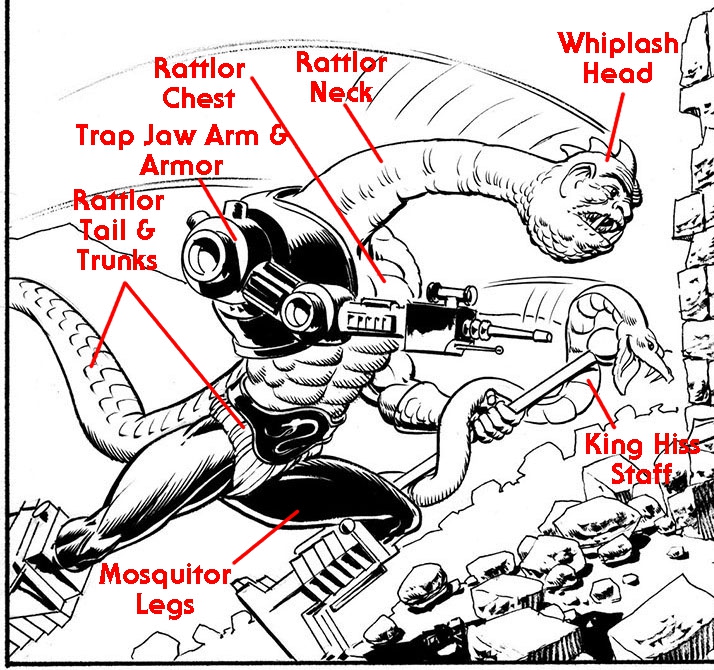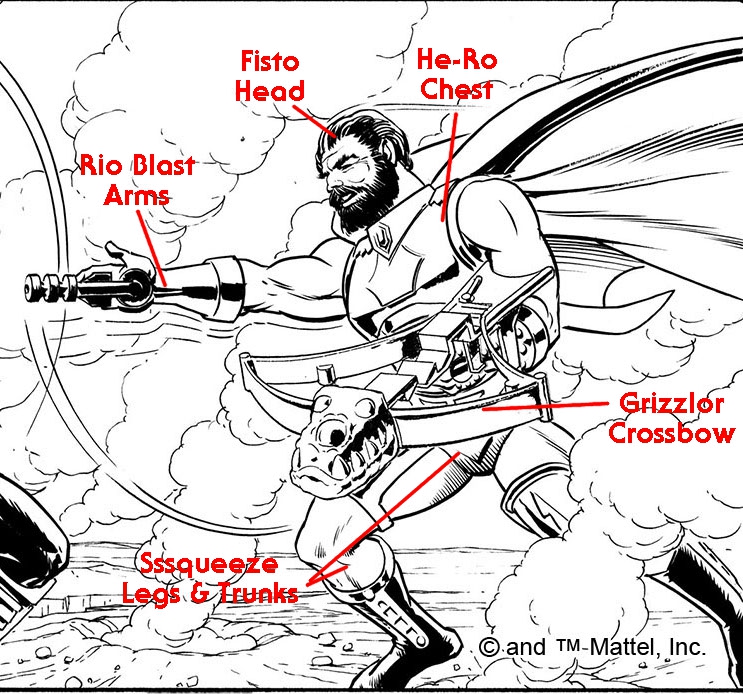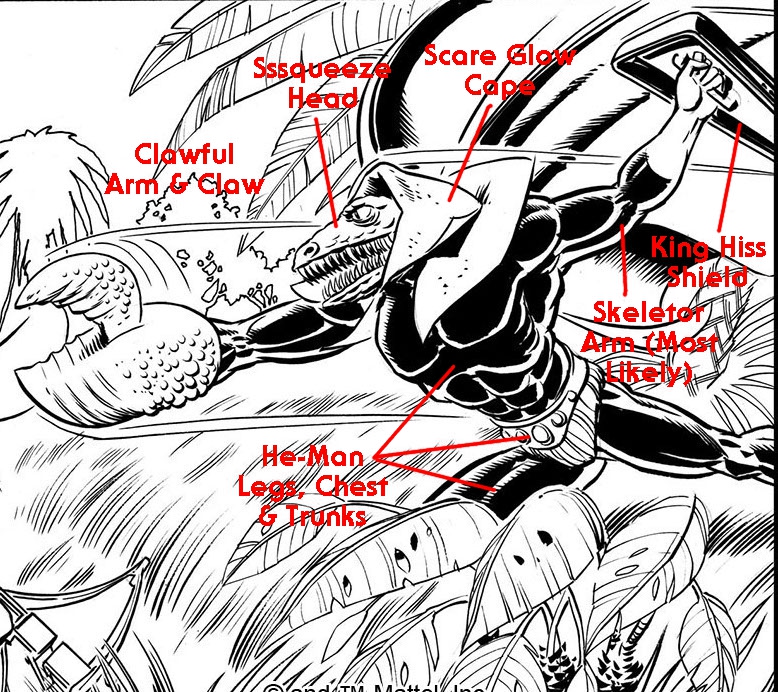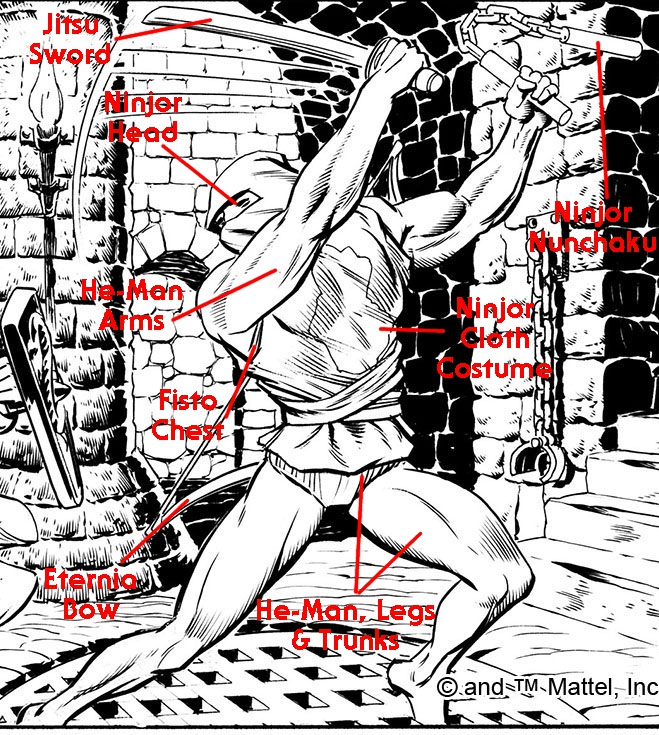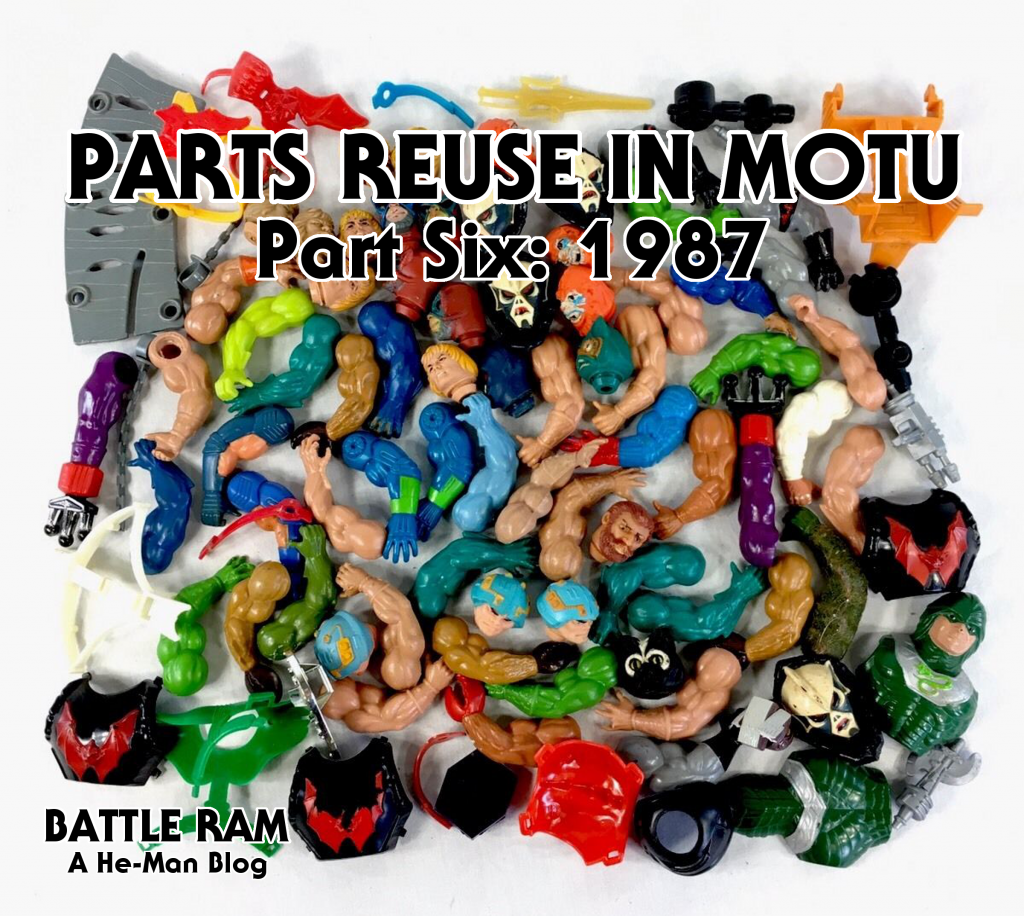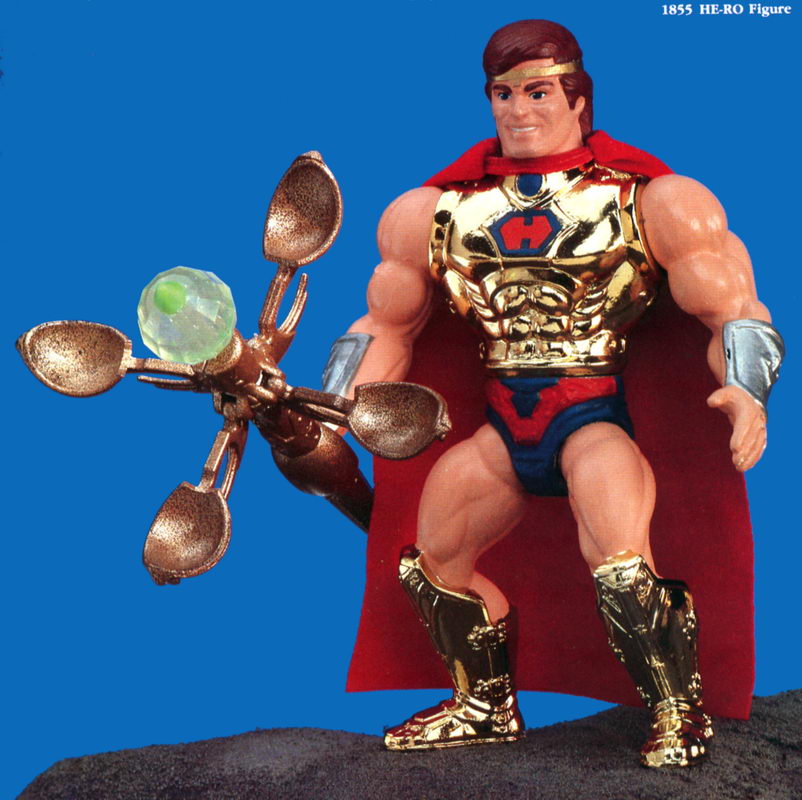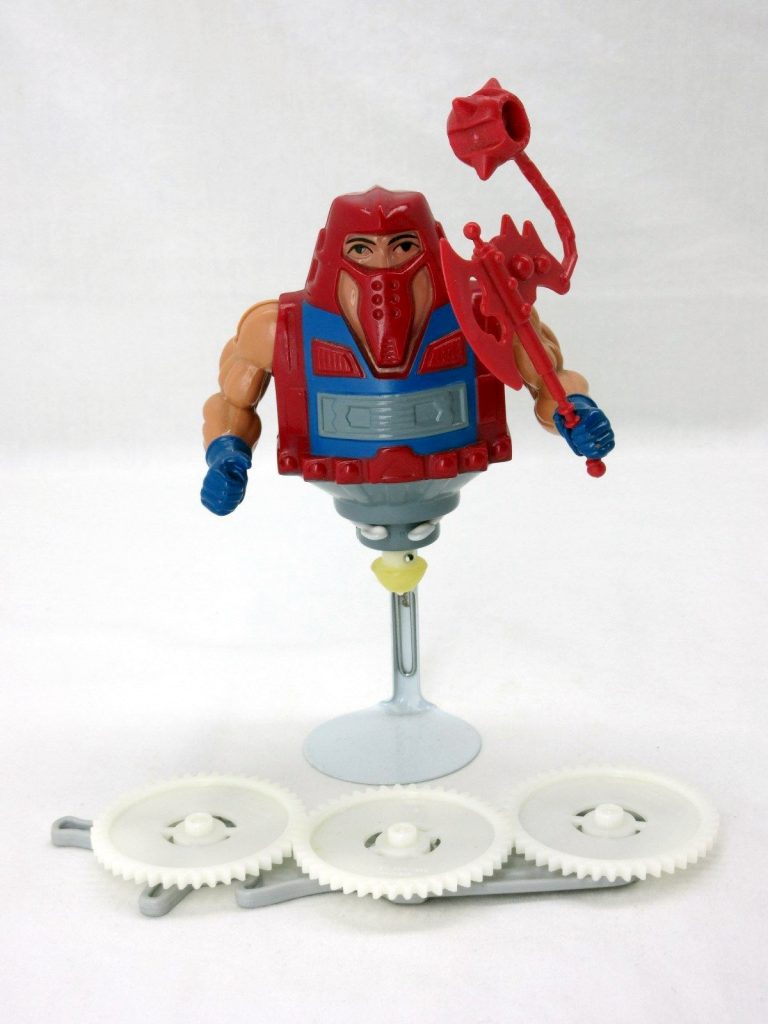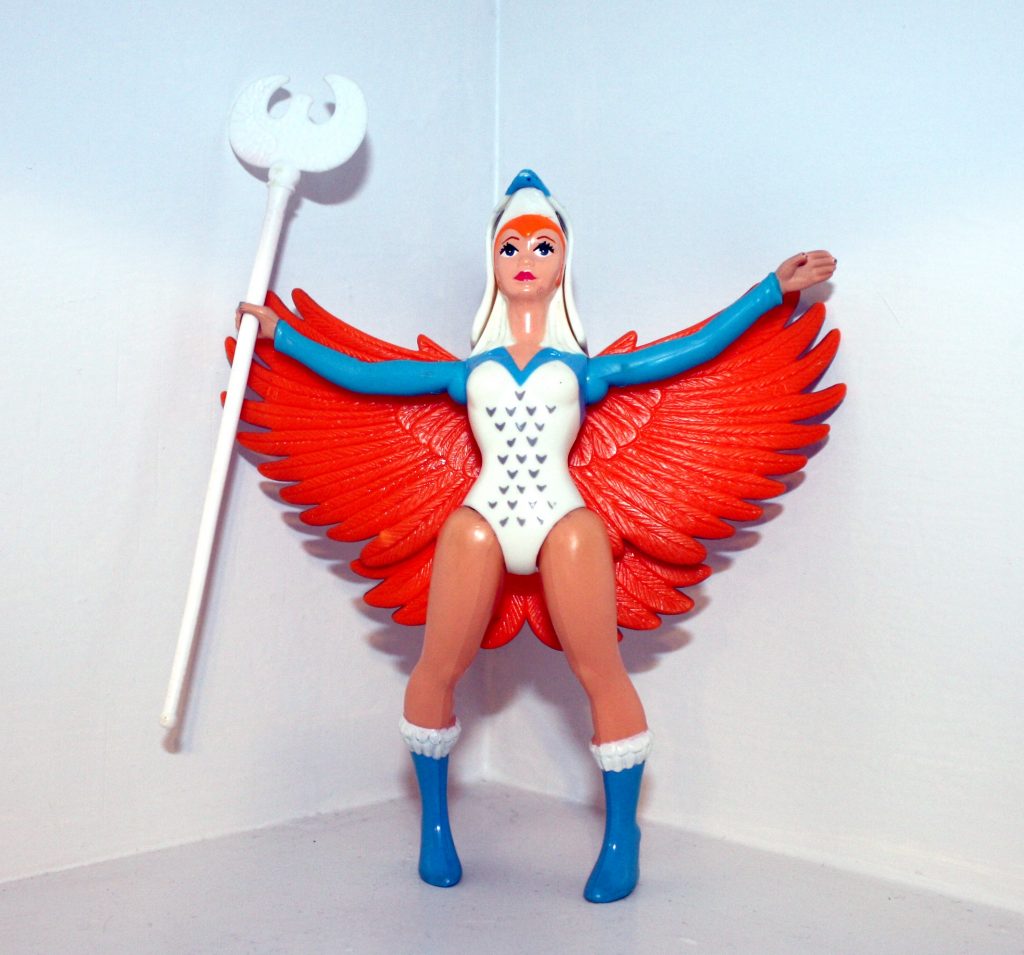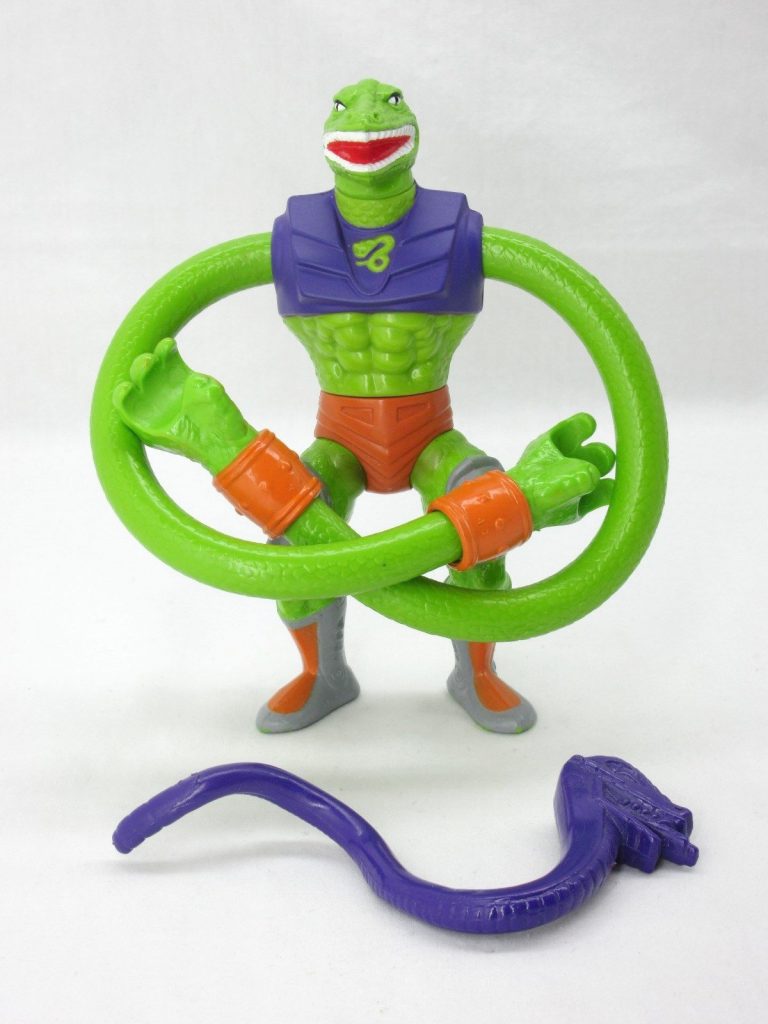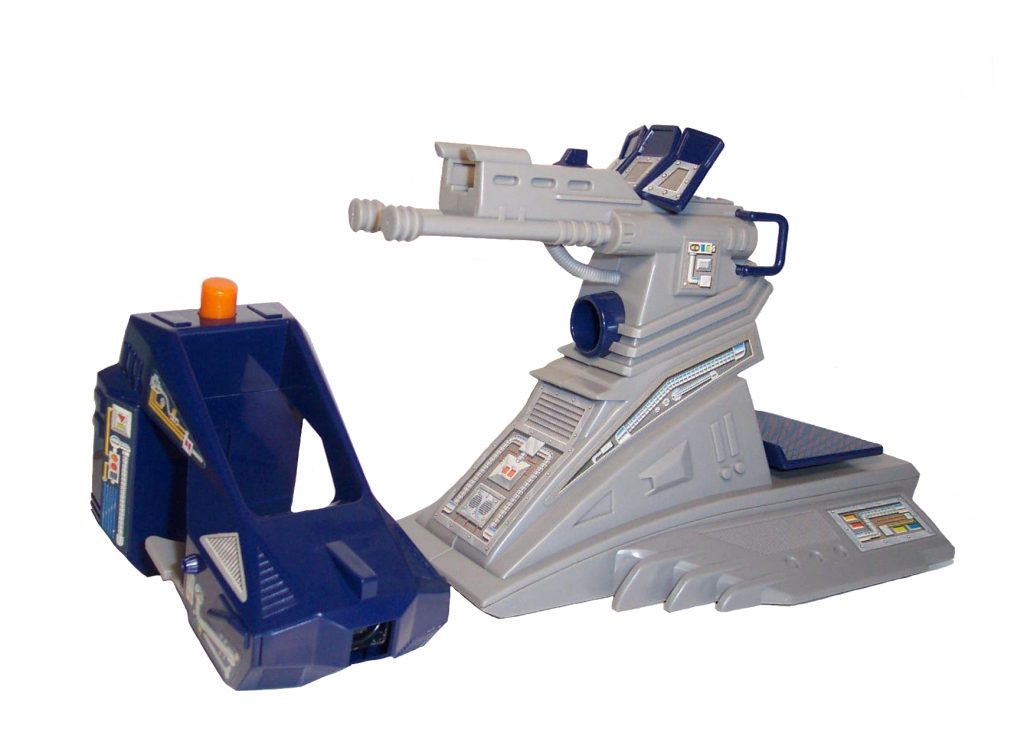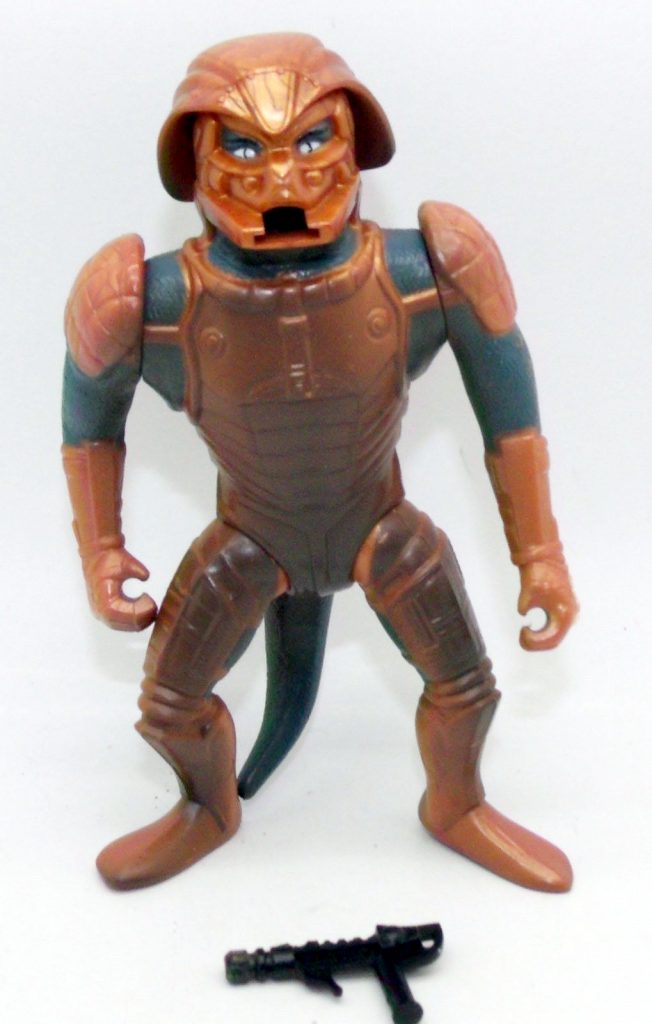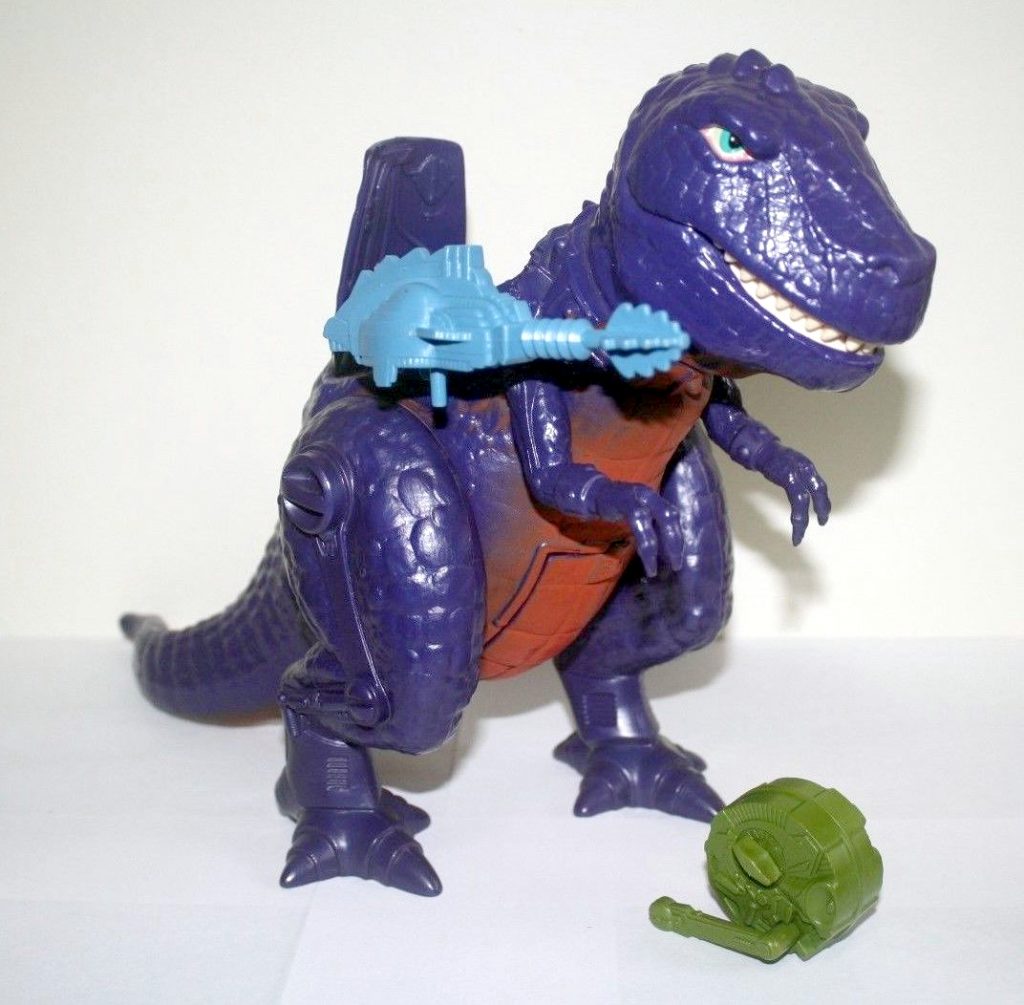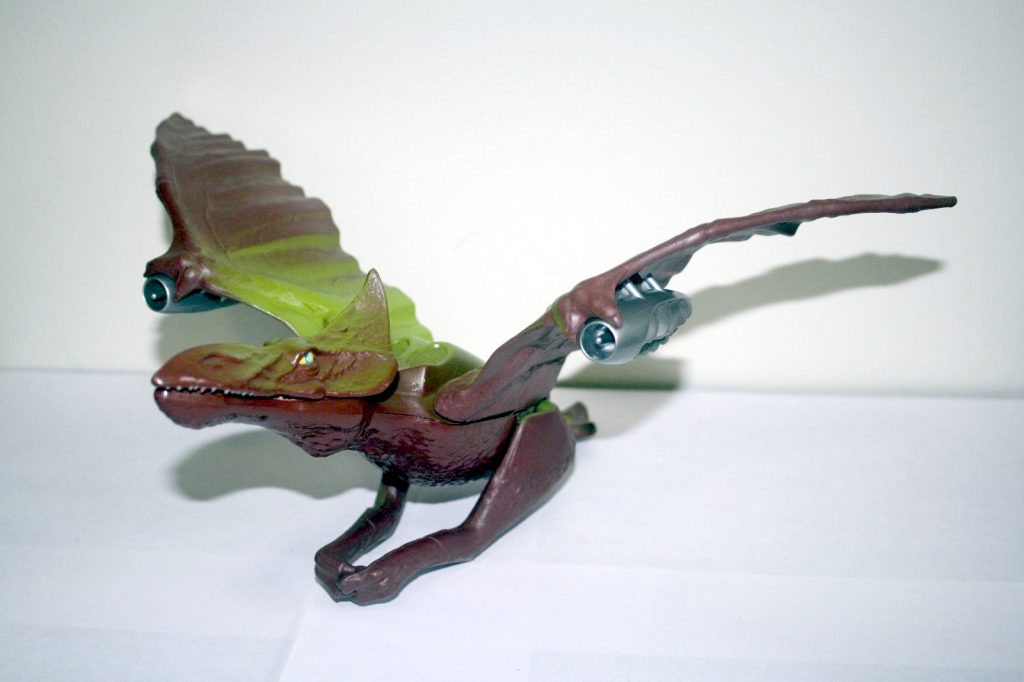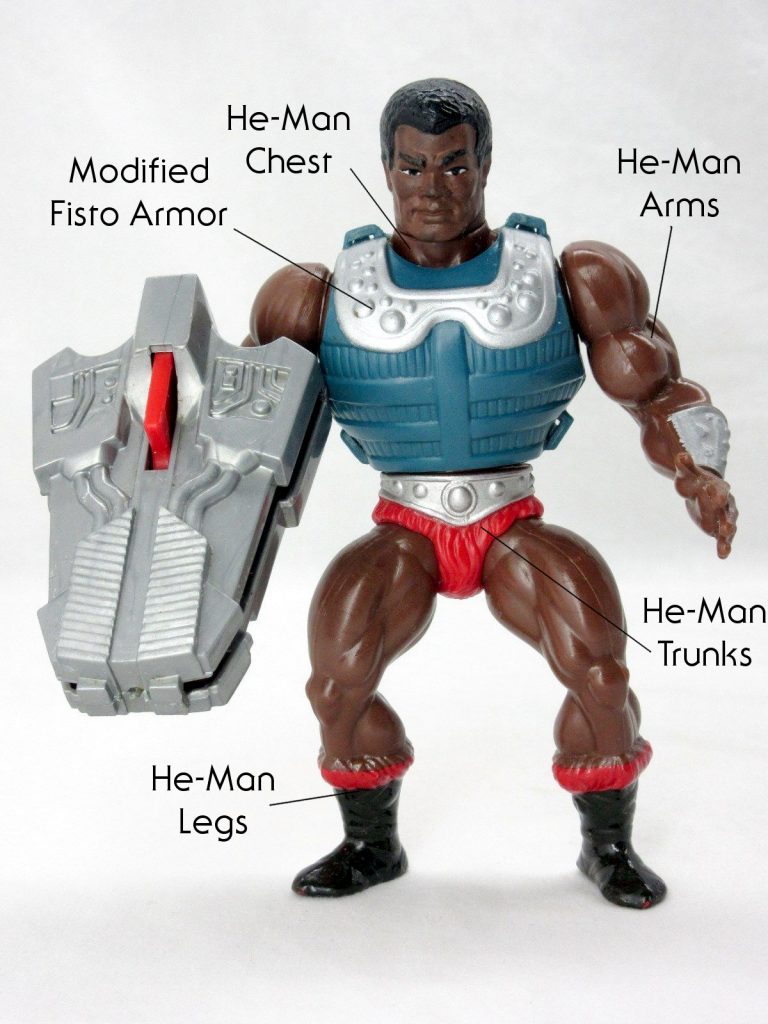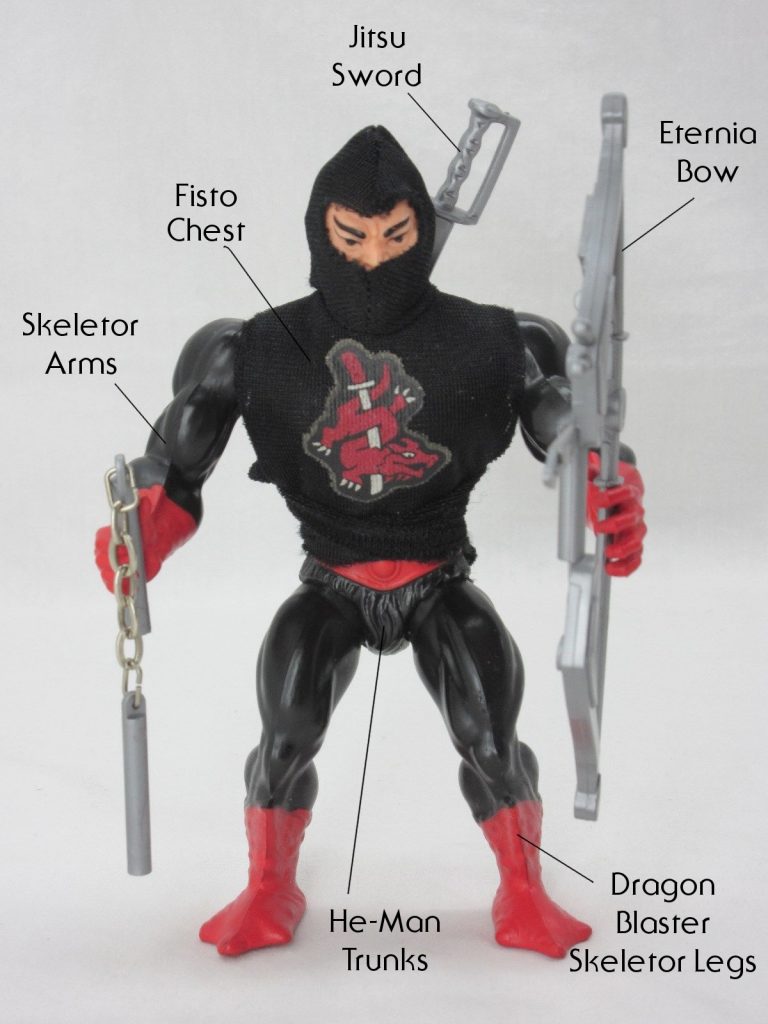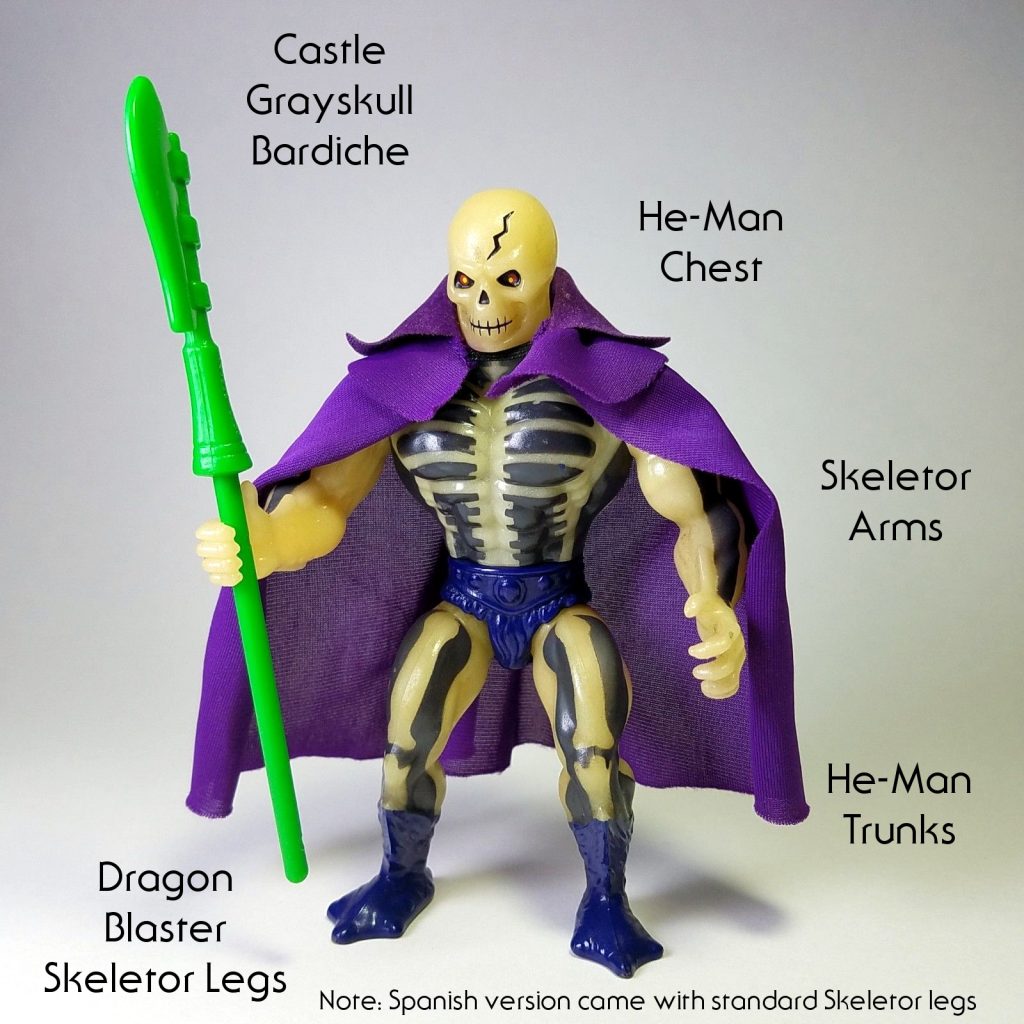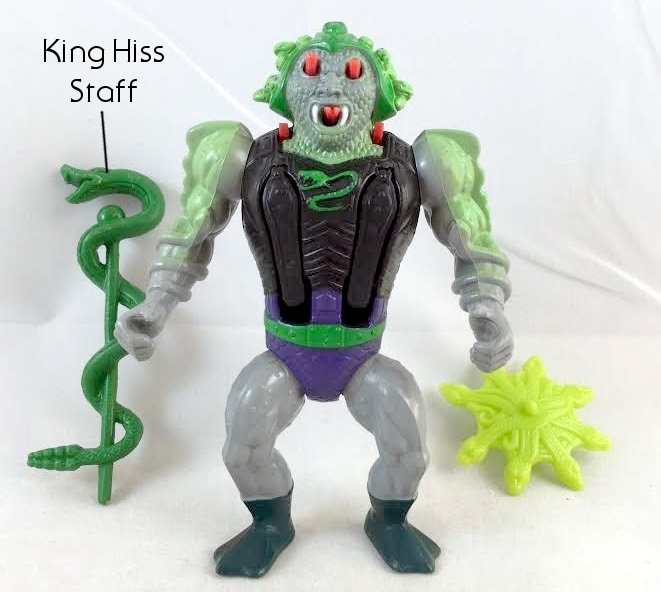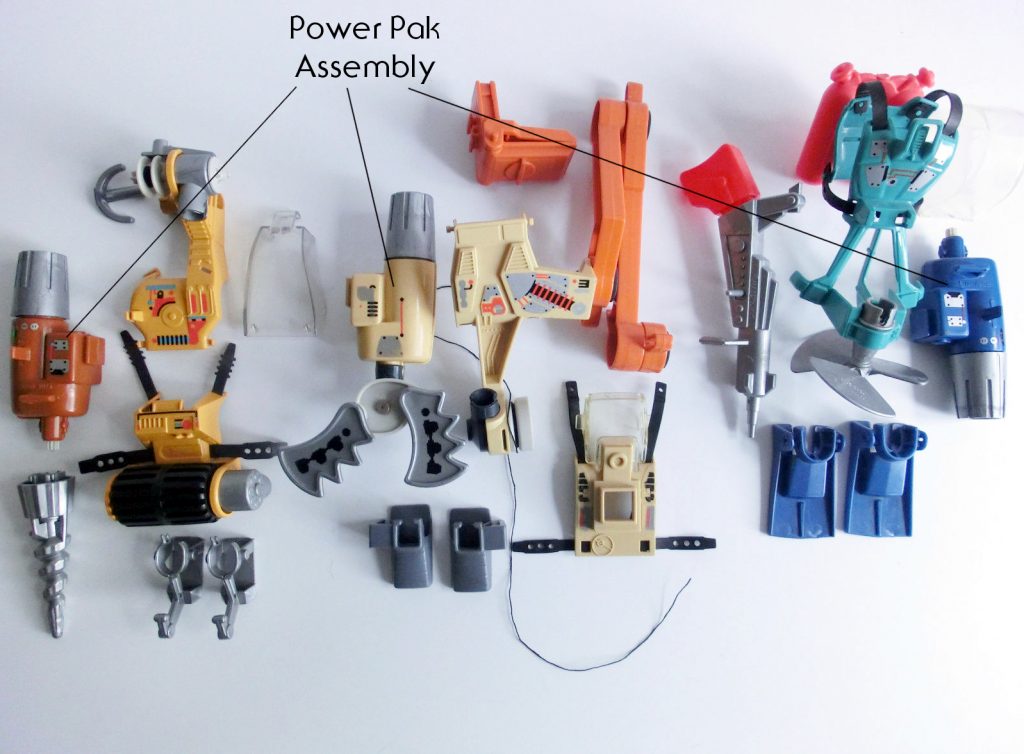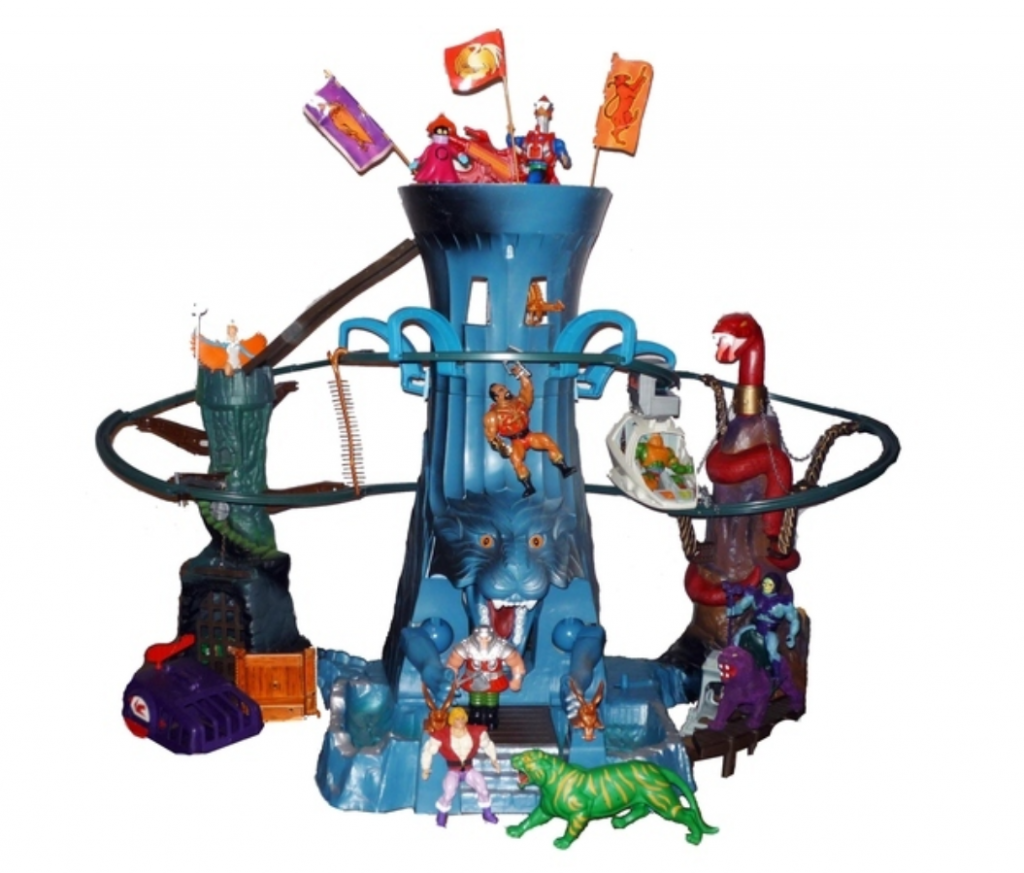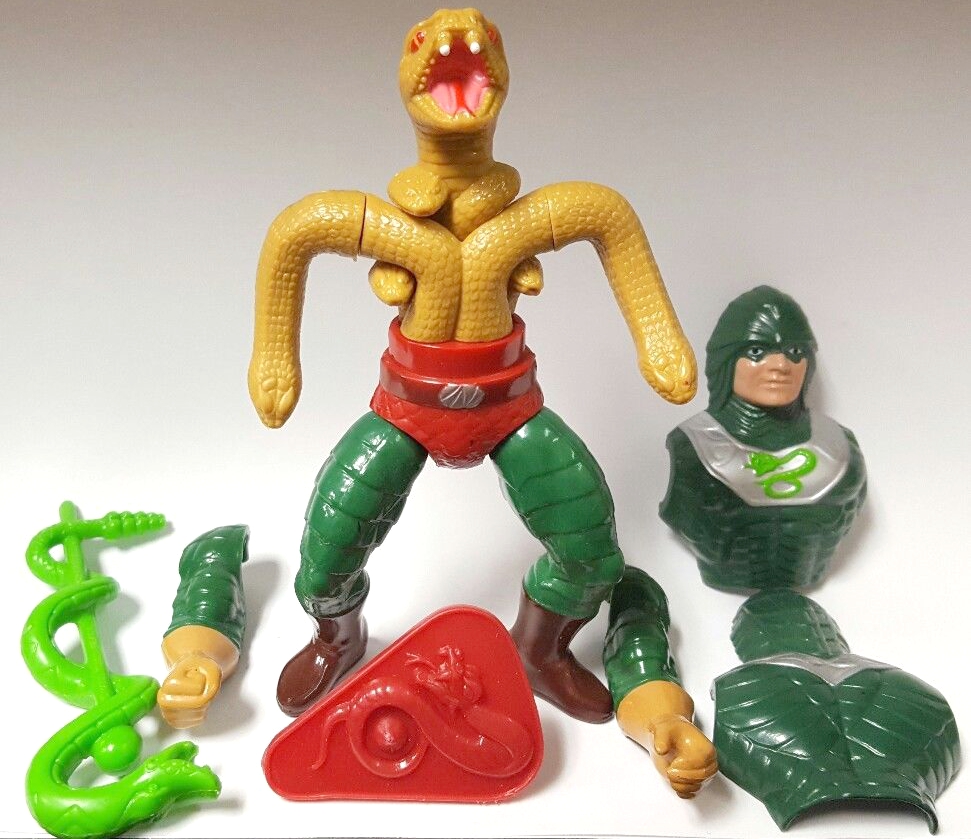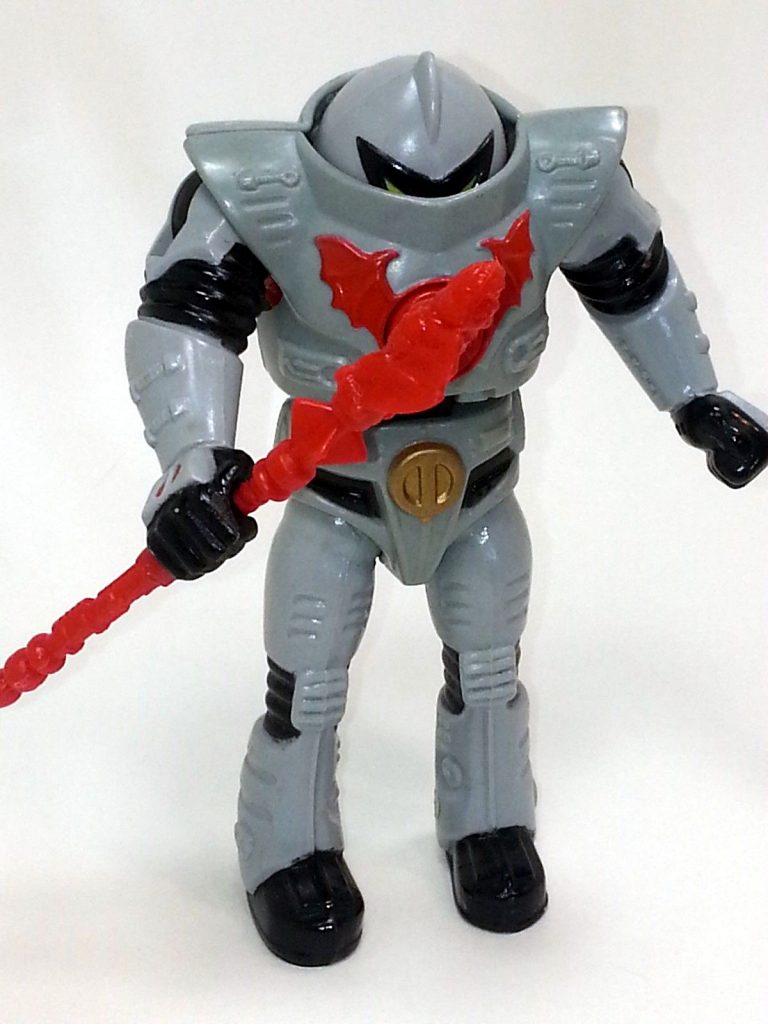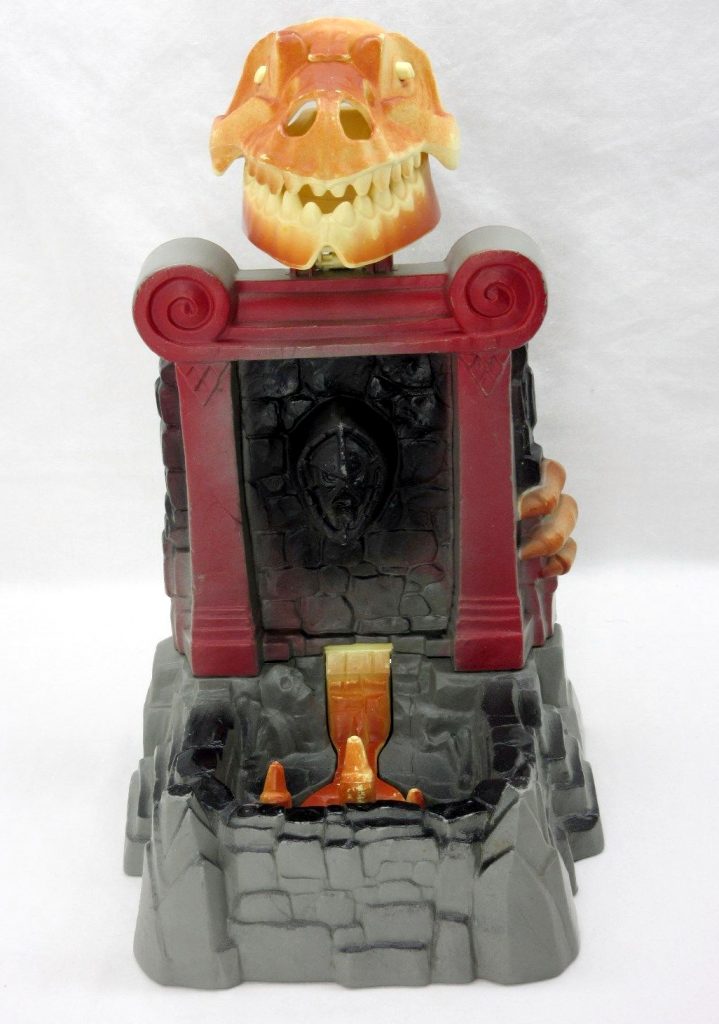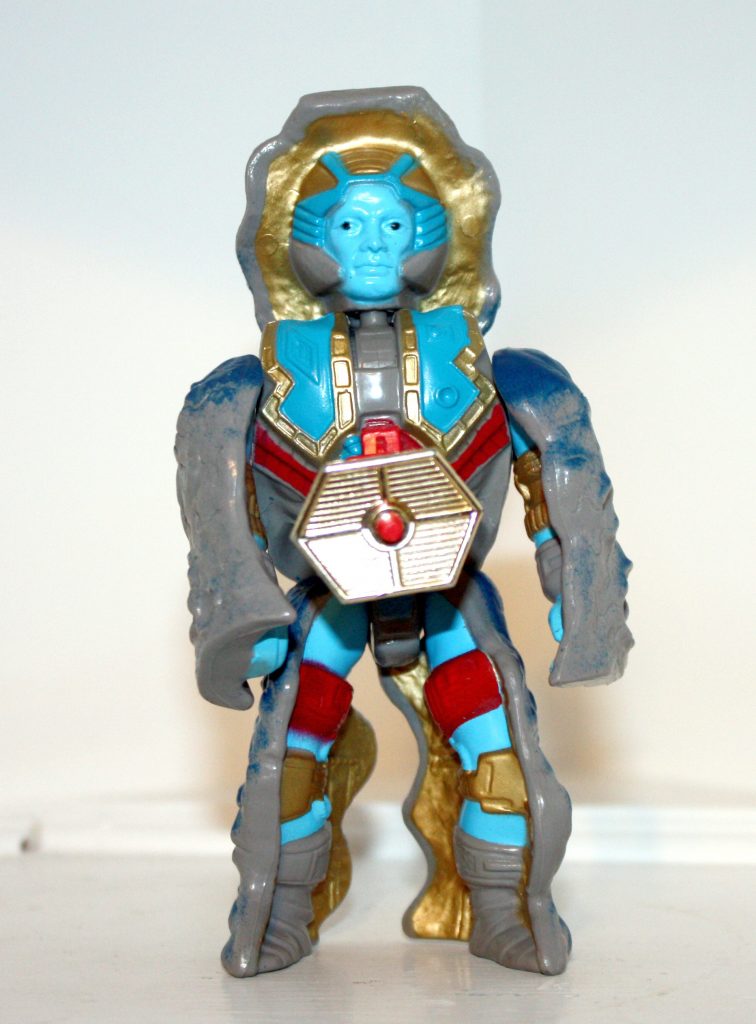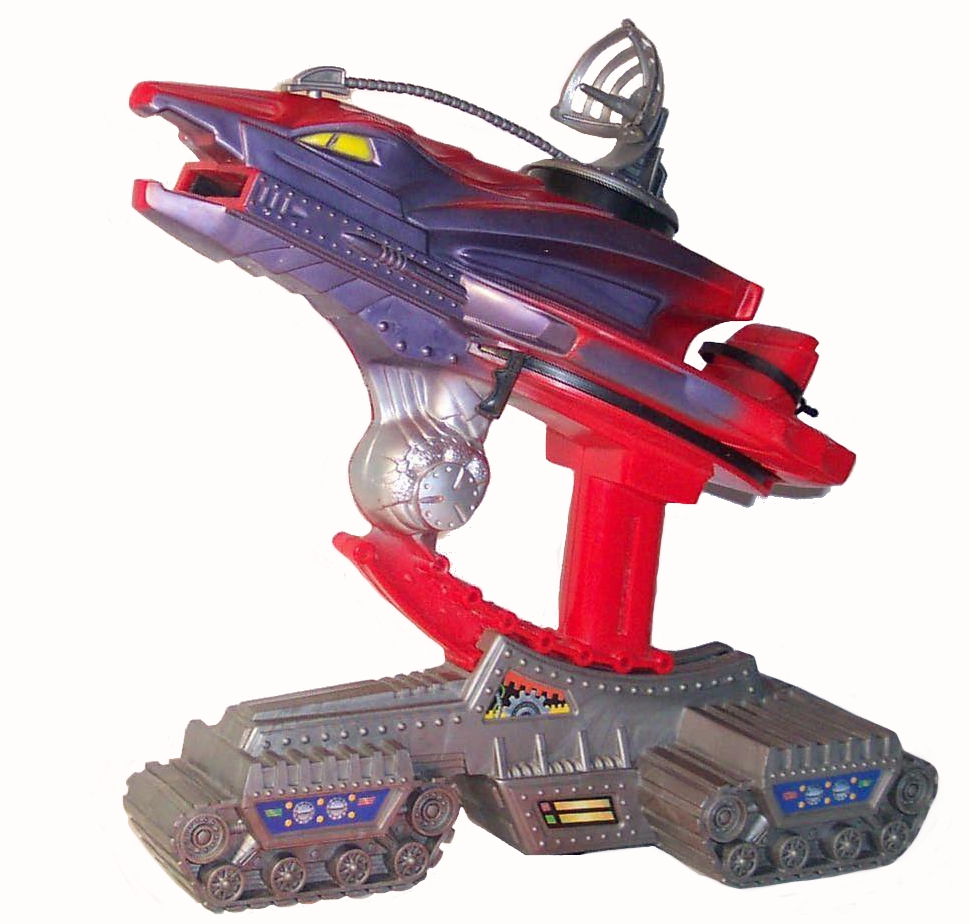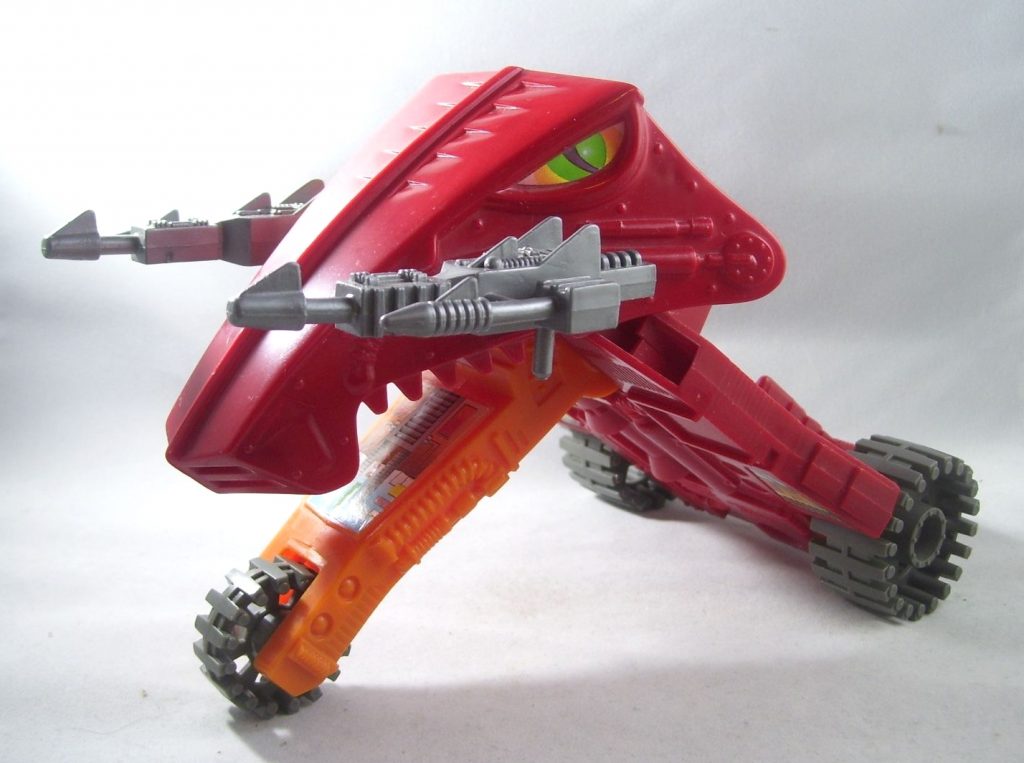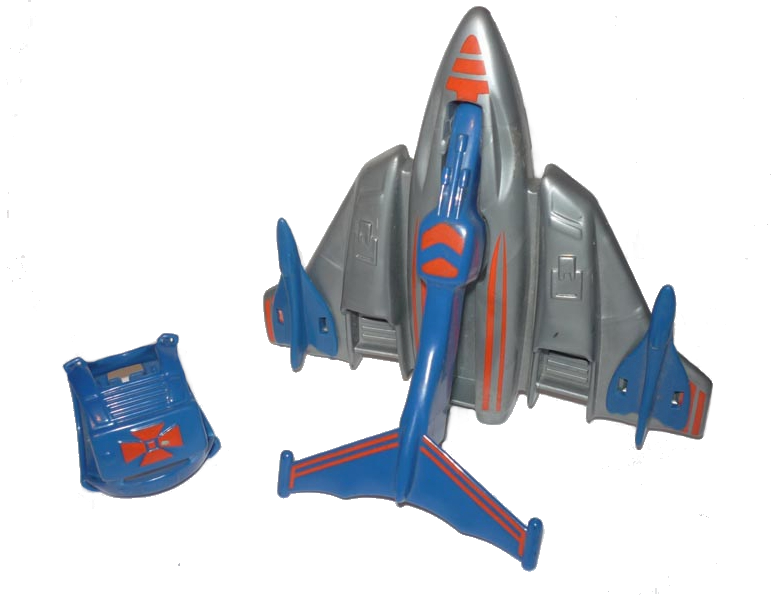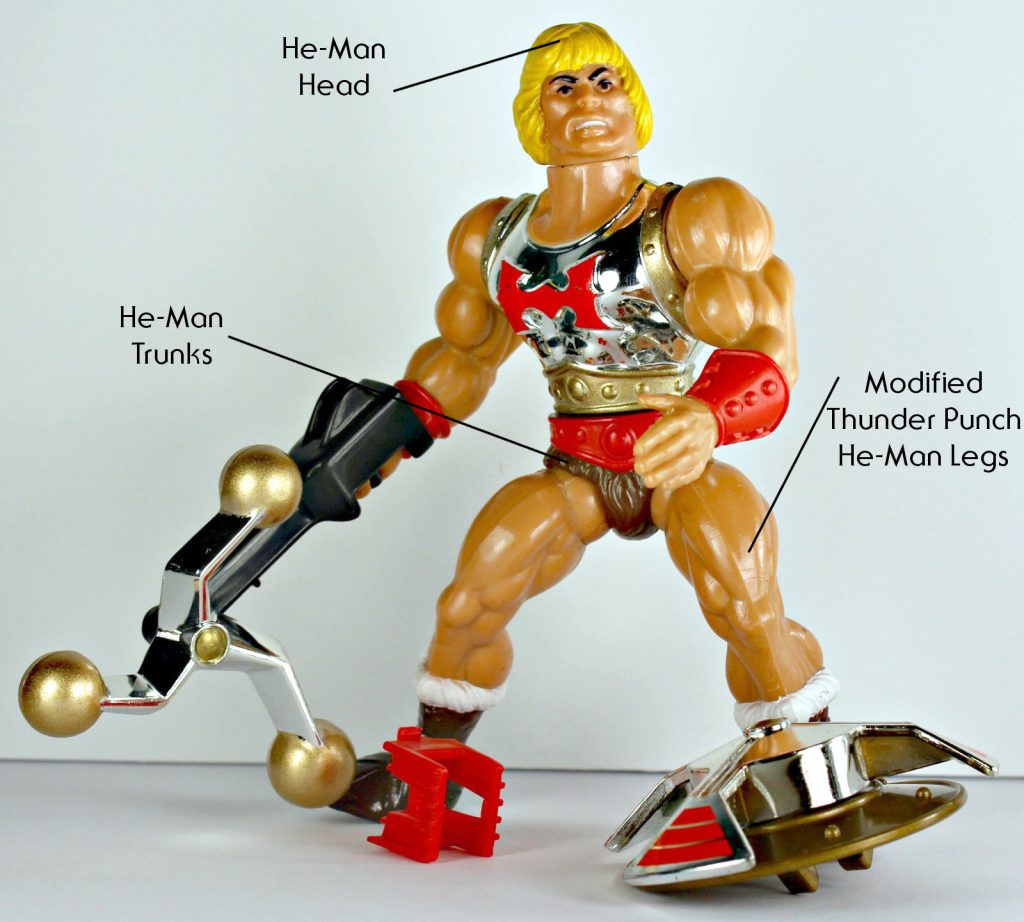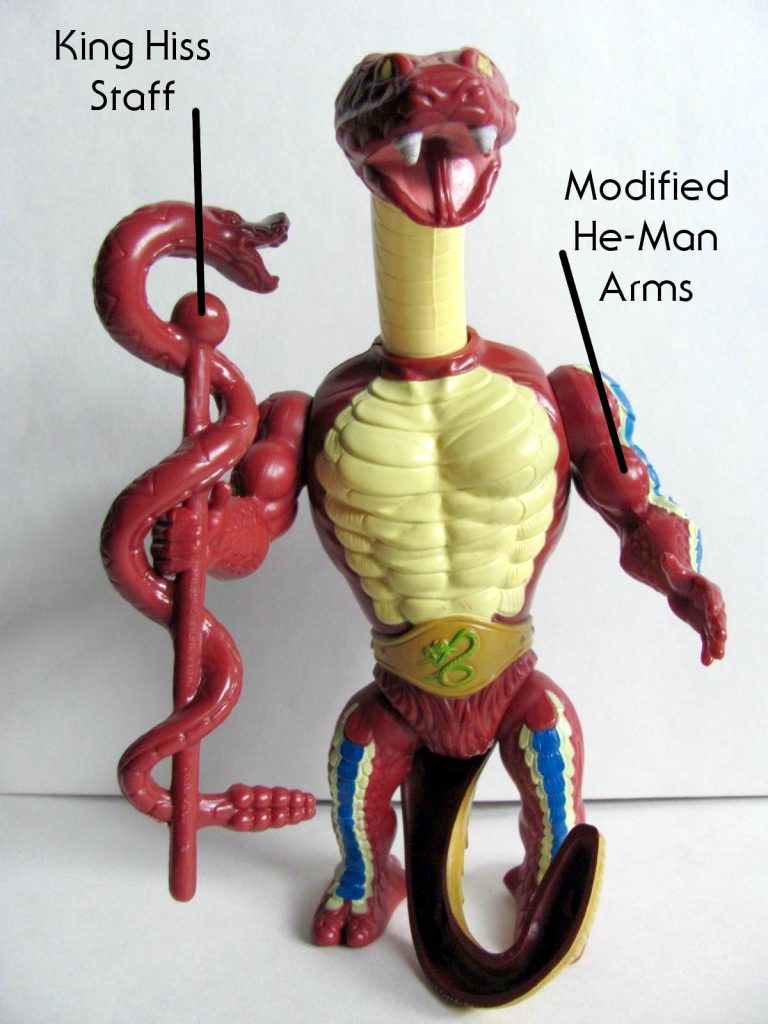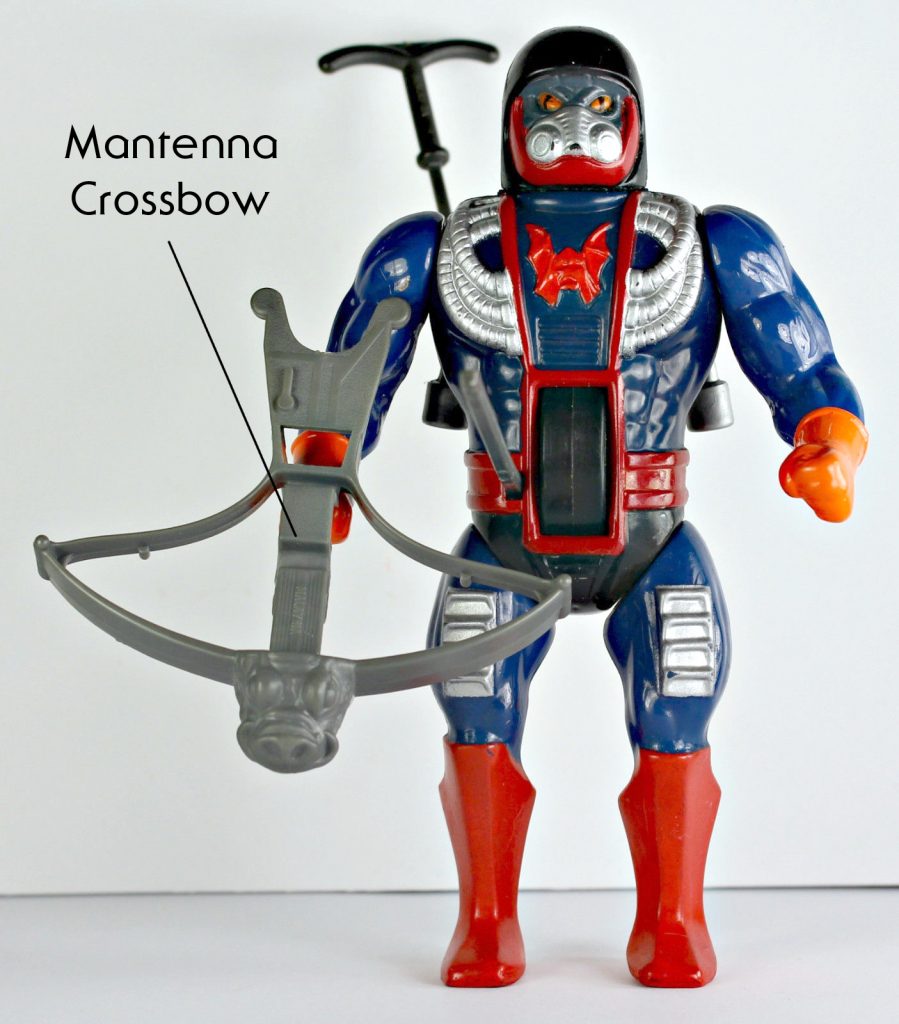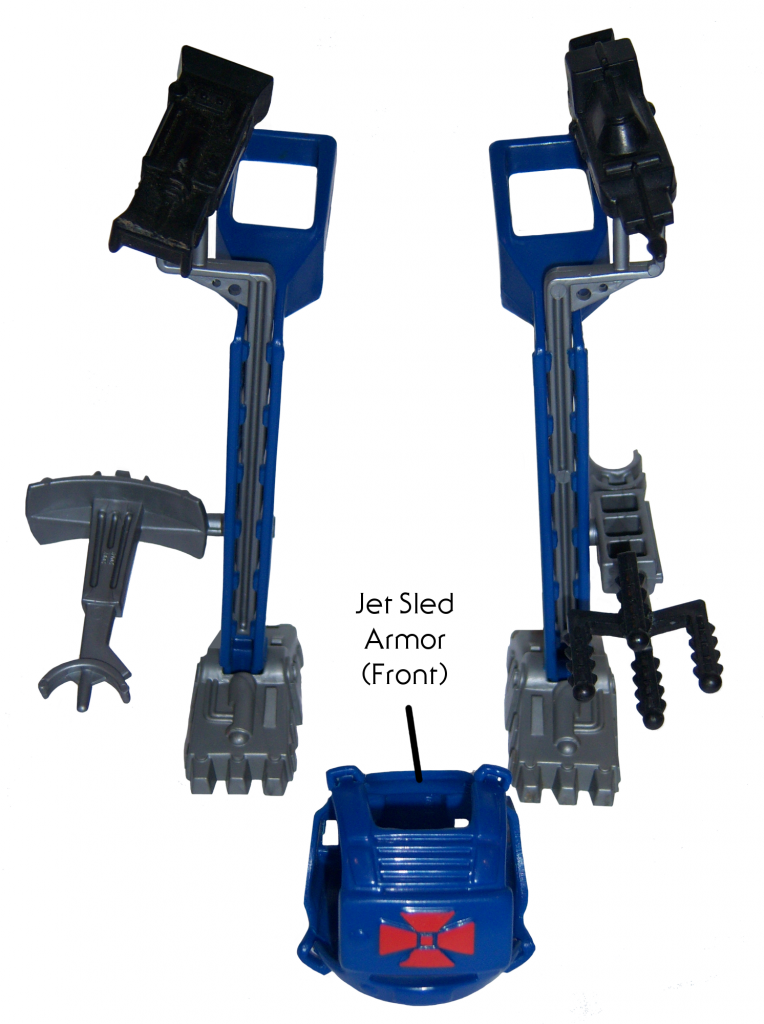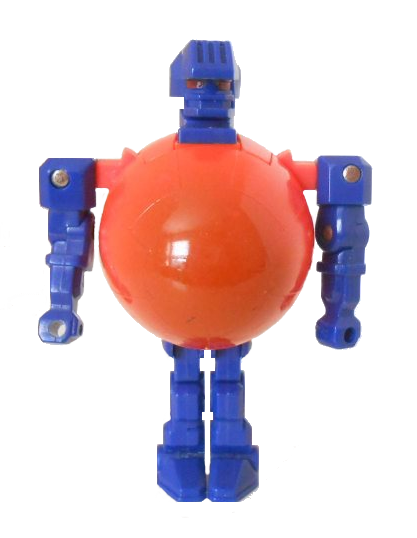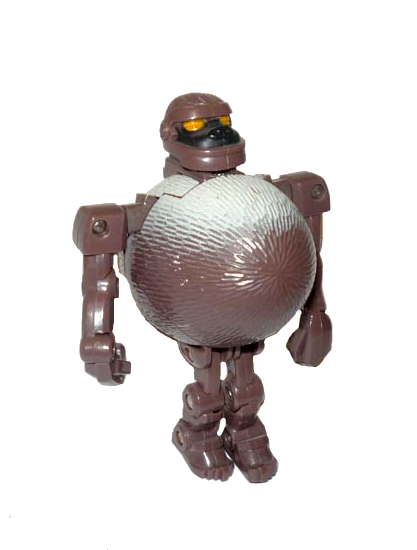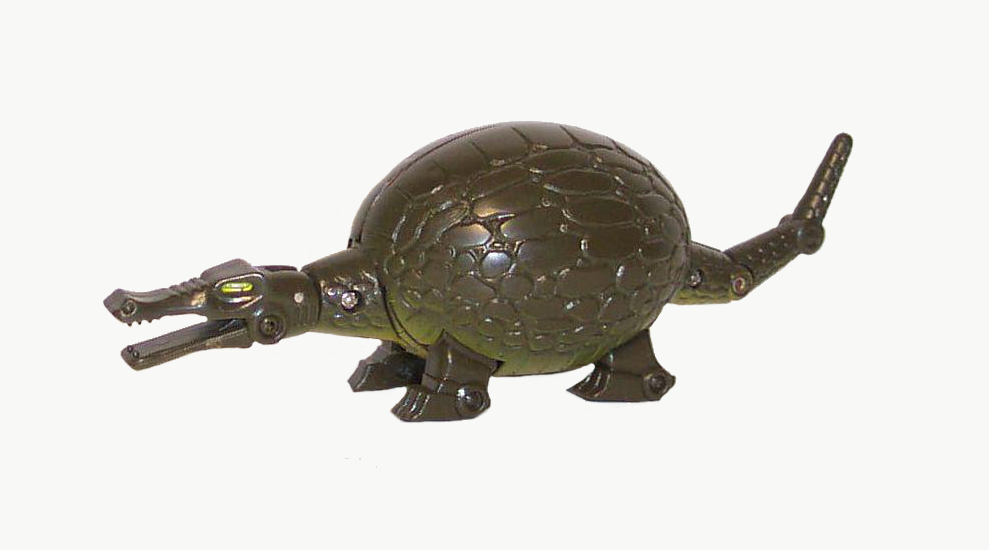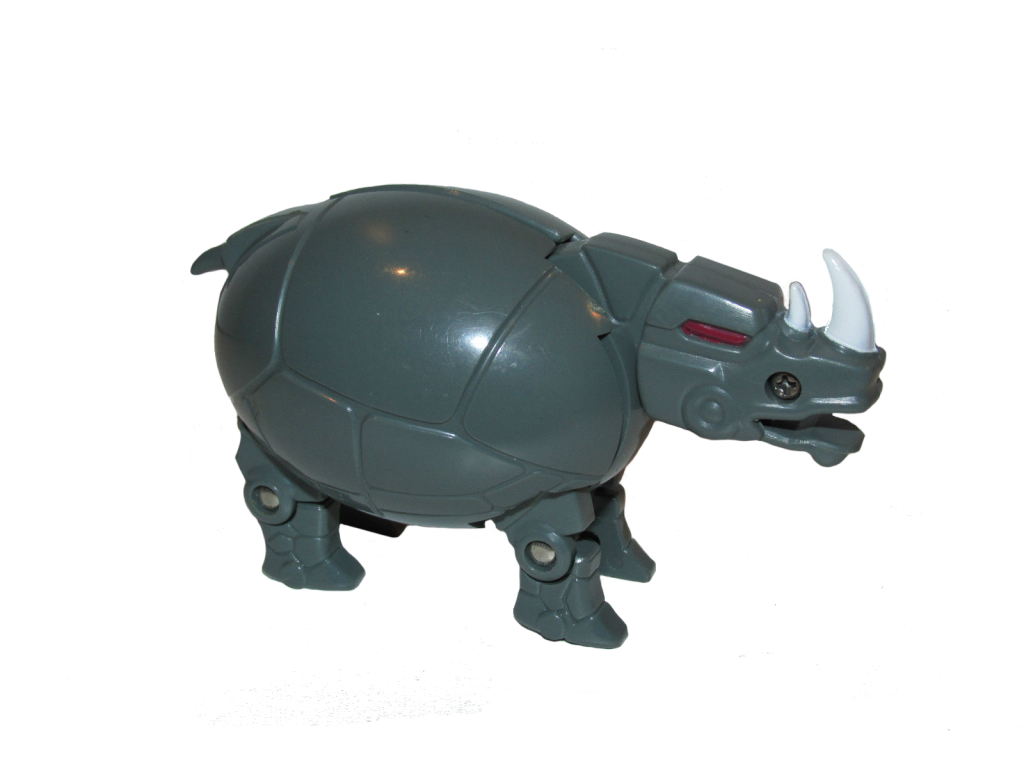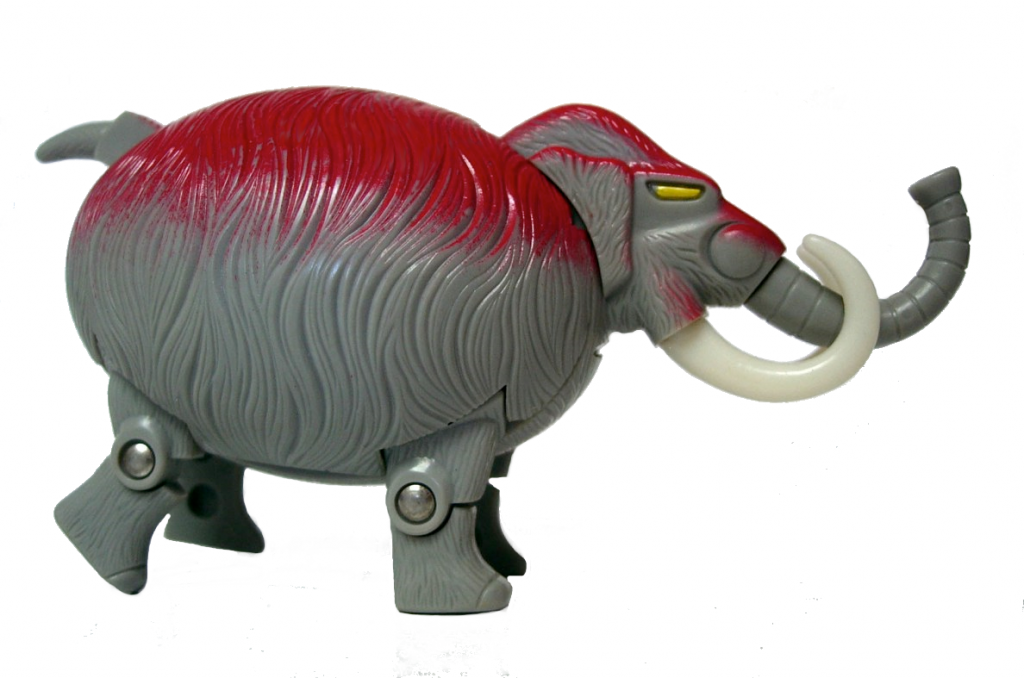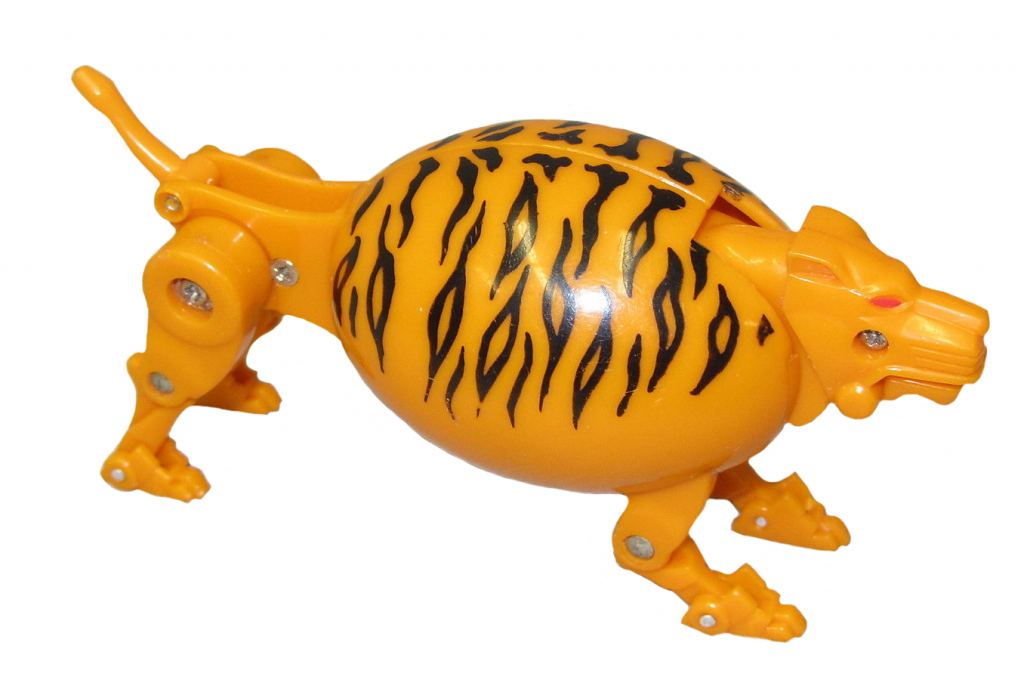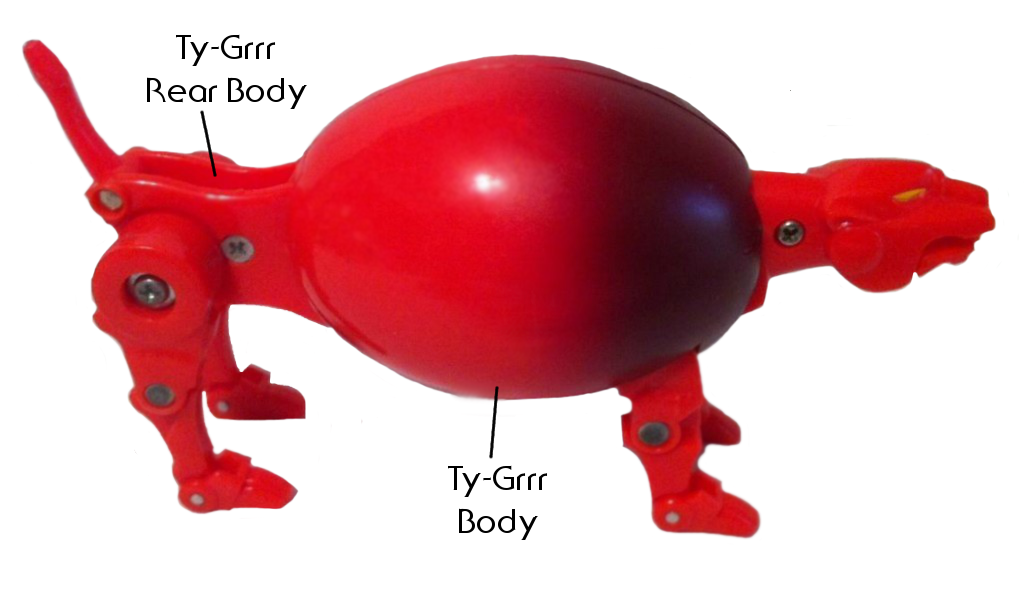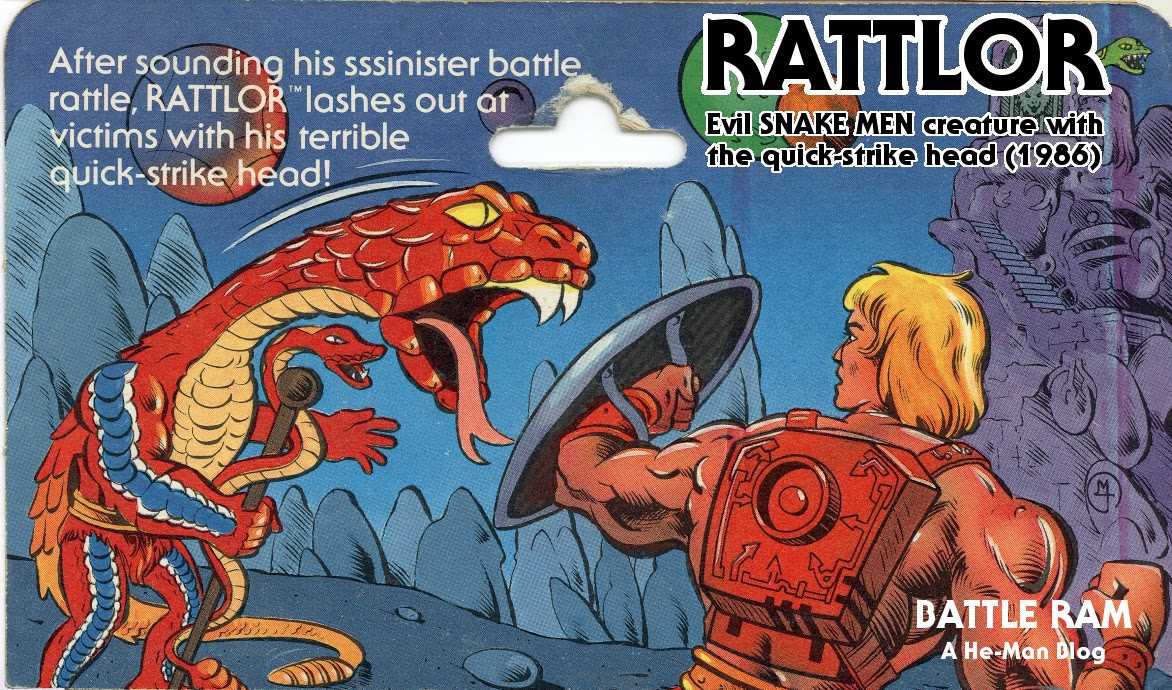
My memory of getting Rattlor is quite vivid. It was our last summer in our Eastern Washington house, before our big move across the mountains to a rainier, more temperate part of the Pacific Northwest, and we were taking a road trip vacation to California before the move. I remember gravely weighing my options at a store along the way. I could get two toys, and I was determined that they be Snake Men.
I was looking at getting Kobra Khan, or perhaps the newly released King Hiss or Rattlor. I don’t remember seeing Tung Lashor at the time. After studying all three toys and their packaging intently, I concluded that King Hiss was a cool idea, but his hidden snake body wasn’t all that great looking, so I went with the other two figures instead.
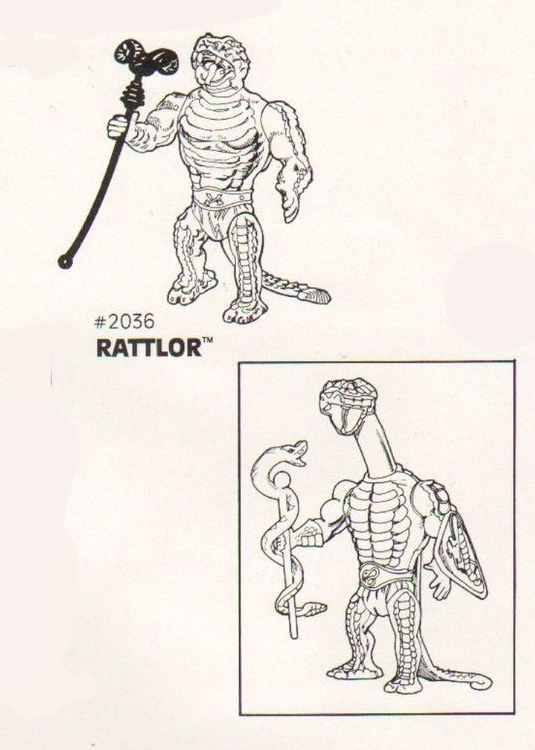
Design & Development
Rattlor started life as a Roger Sweet concept, although in this very early concept drawing he’s barely recognizable. As is evident in the artwork, he was to have a yellow and green color scheme and would have reused Buzz-Off’s legs and Skeletor’s arms, just like Whiplash. If you look carefully you can see the rattle at the end of his tail, without which we would have no visual cues to assume this character was based on a rattle snake. There are no obvious signs that his head was to have the pop-out action feature. This design came about sometime around 1983, at the same time Whiplash and other third wave characters were being developed, per Aidan in the comment section.

Ted Mayer’s Basher concept illustrates the general idea for Rattlor’s action feature. In this illustration the character’s head is being used as a blunt weapon, but of course for Rattlor the idea was that he could quickly strike his head forward and deliver a bite.
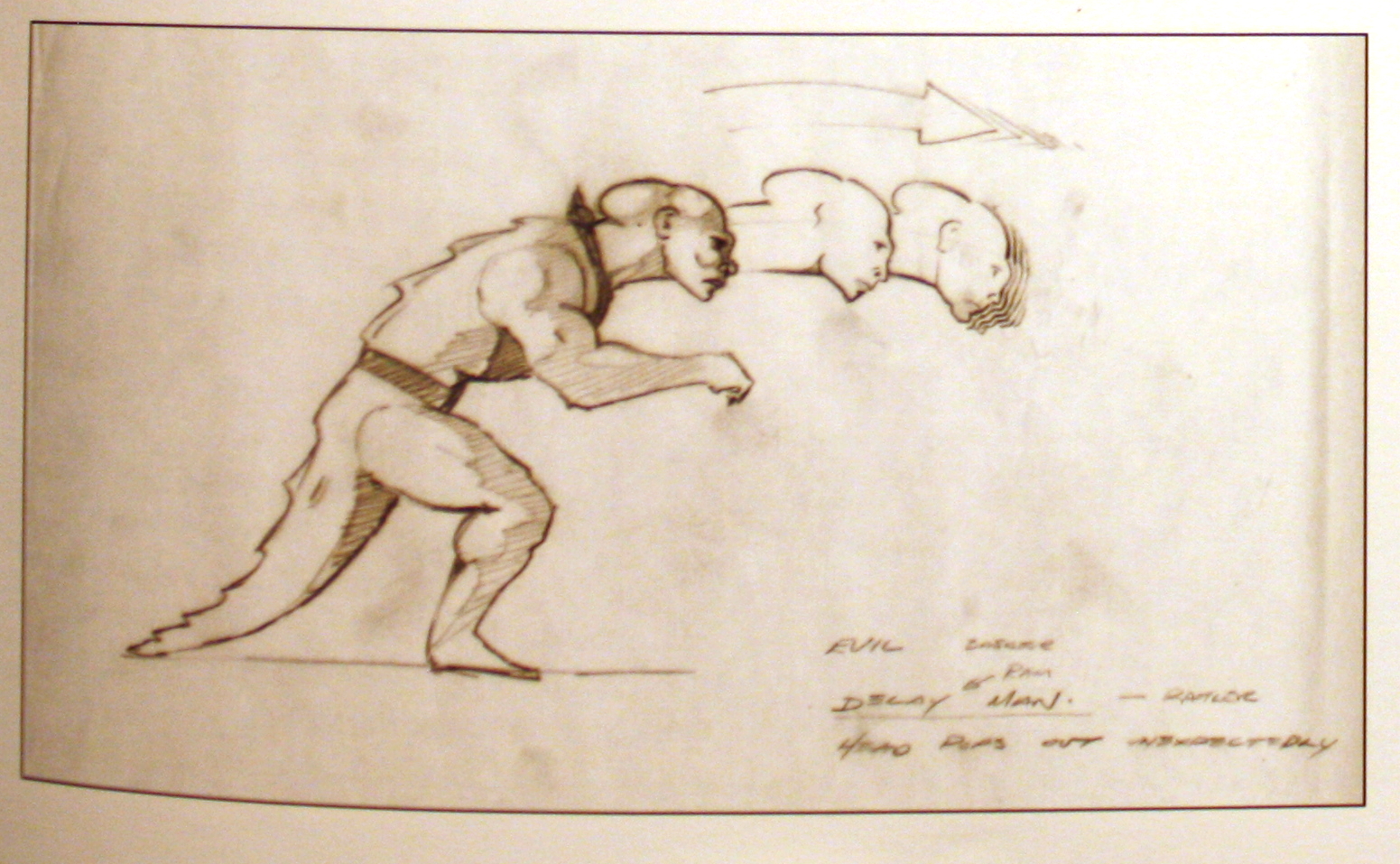
As for the snake Men, Rattlor and Tung Lashor were designed ahead of King Hiss (and included as Horde Villains based on their earliest designs). By the time King Hiss was completed and the Snake Men as a faction had been created, She-Ra was already in full swing.
James Eatock
Depictions of Rattlor in the minicomics give us a glimpse of an intermediate design. He is usually depicted with the dragon-like spines from the prototype, but with the updated scaly limbs and two-toed feet that were used in the final toy. This represents a mid-point in Rattlor’s design evolution. Most of these appearances feature the character with his final rust, cream and blue color scheme, but in his first appearance he is yellowish orange.



Update: MOTU Joe has unearthed a trove of concept images, which include a couple of closer-to-final designs for Rattlor. If I learn more and get better images, I’ll update this article again:
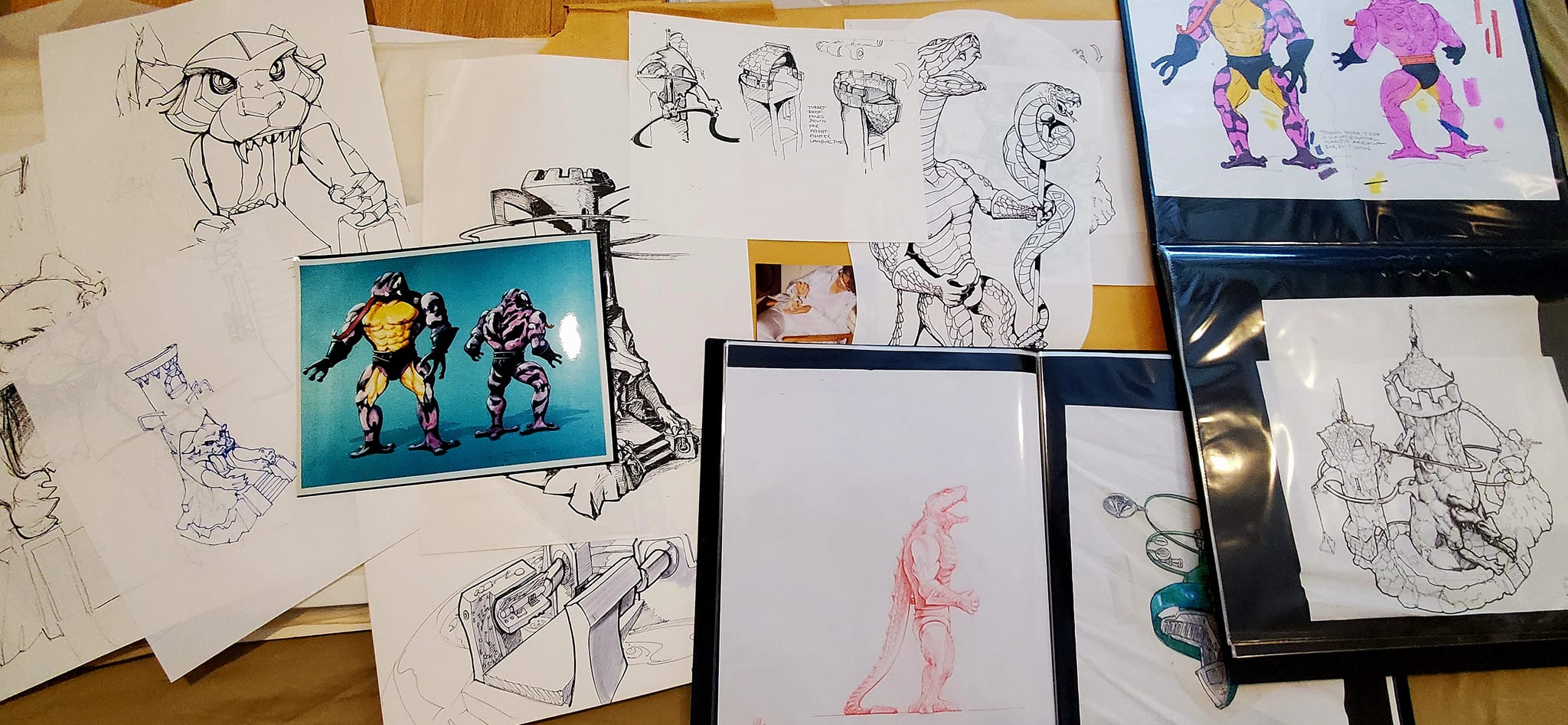
Production Toy
The actual toy has an elongated neck and a tail with a sculpted rattle at the end of it, but otherwise it has little in common with Sweet’s initial design, and the final toy was redesigned by John Hollis, who also worked on Extendar and Turbodactyl. The toy’s head certainly looks much more rattle snake-like than the concept artwork. Rattlor lost the spines along his back, and the final figure featured all new limbs. He came with a staff borrowed from King Hiss, but molded in brick red plastic.
In order to accommodate Rattlor’s long neck when it was recessed, his torso had to be quite large compared to most He-Man figures. His legs are relatively short, however – they’re about the size of Beast Man’s legs, but look even more undersized because of his large torso. His arms look like they were based on the He-Man’s arms (with a similar open left hand) with added scales and gloves, and slightly different musculature. Curiously, the staff is omitted in the cross sell artwork below:
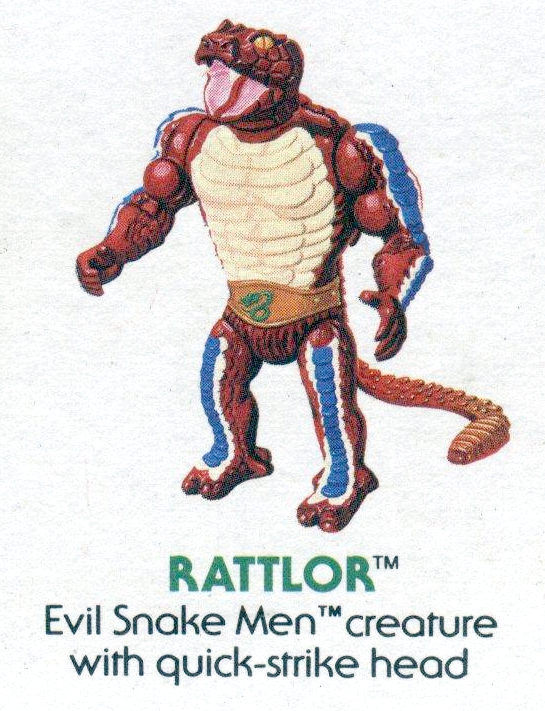
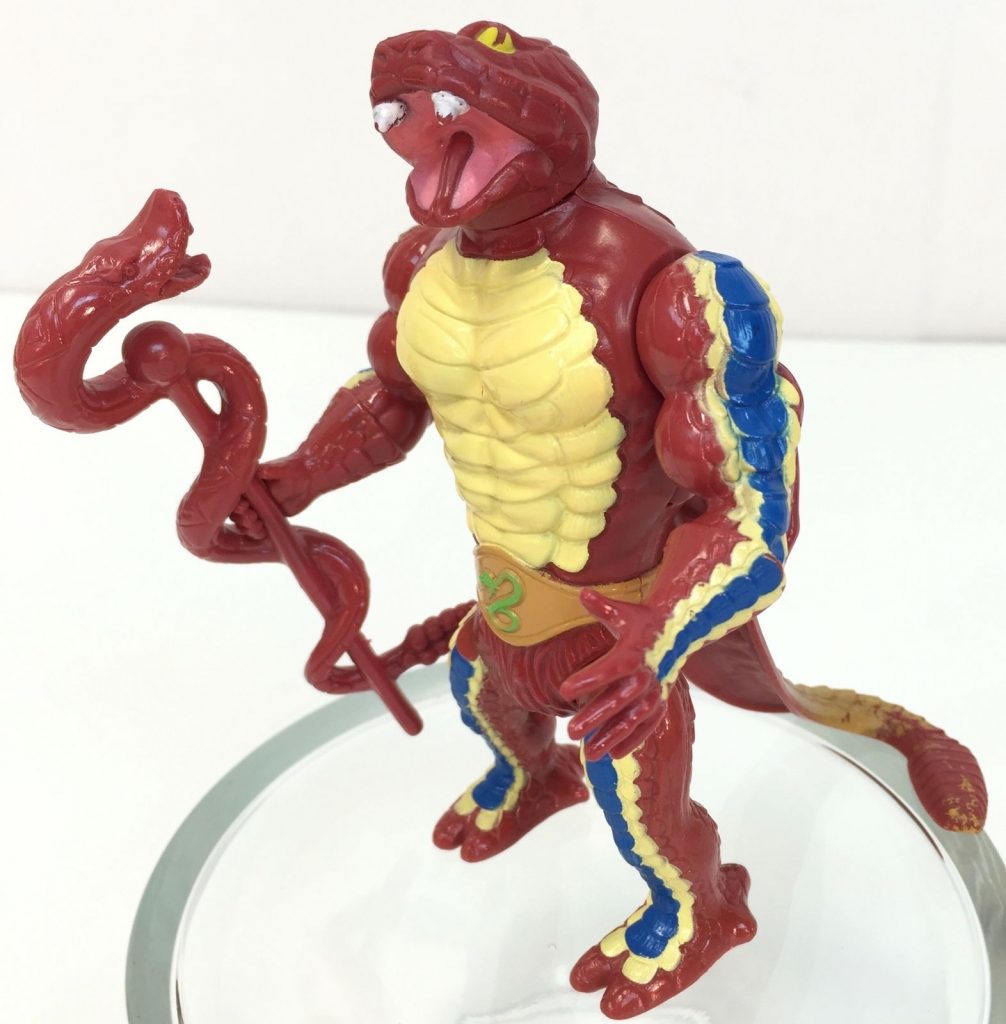
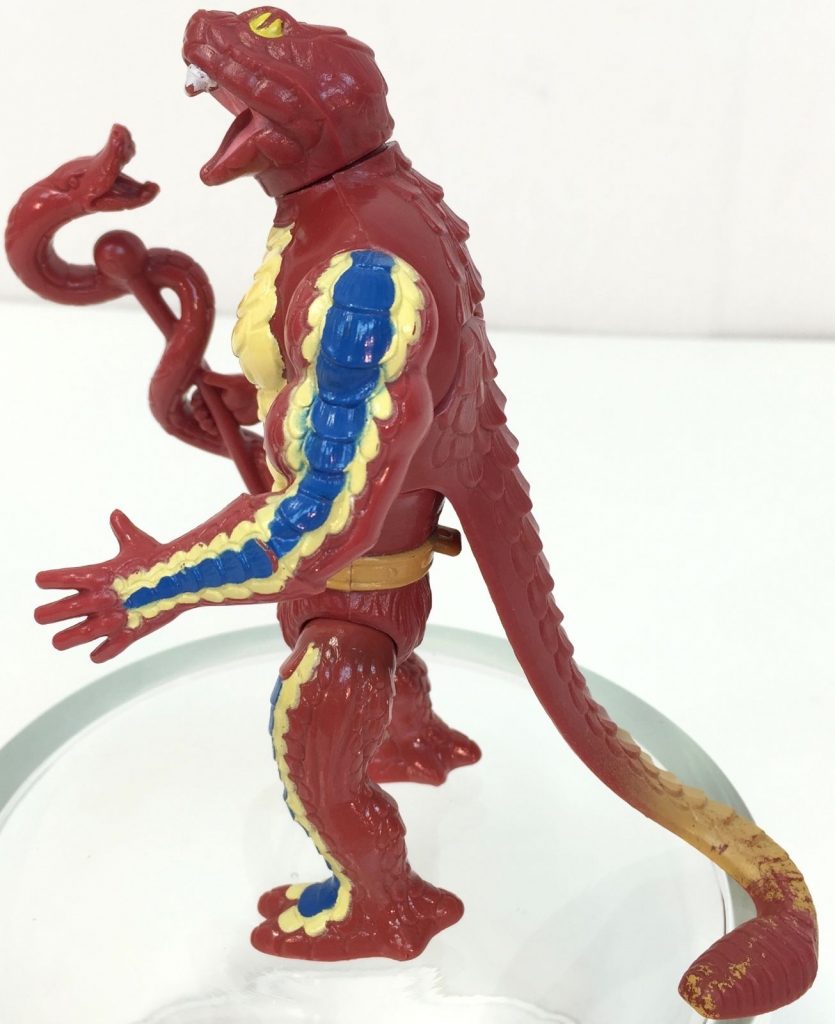

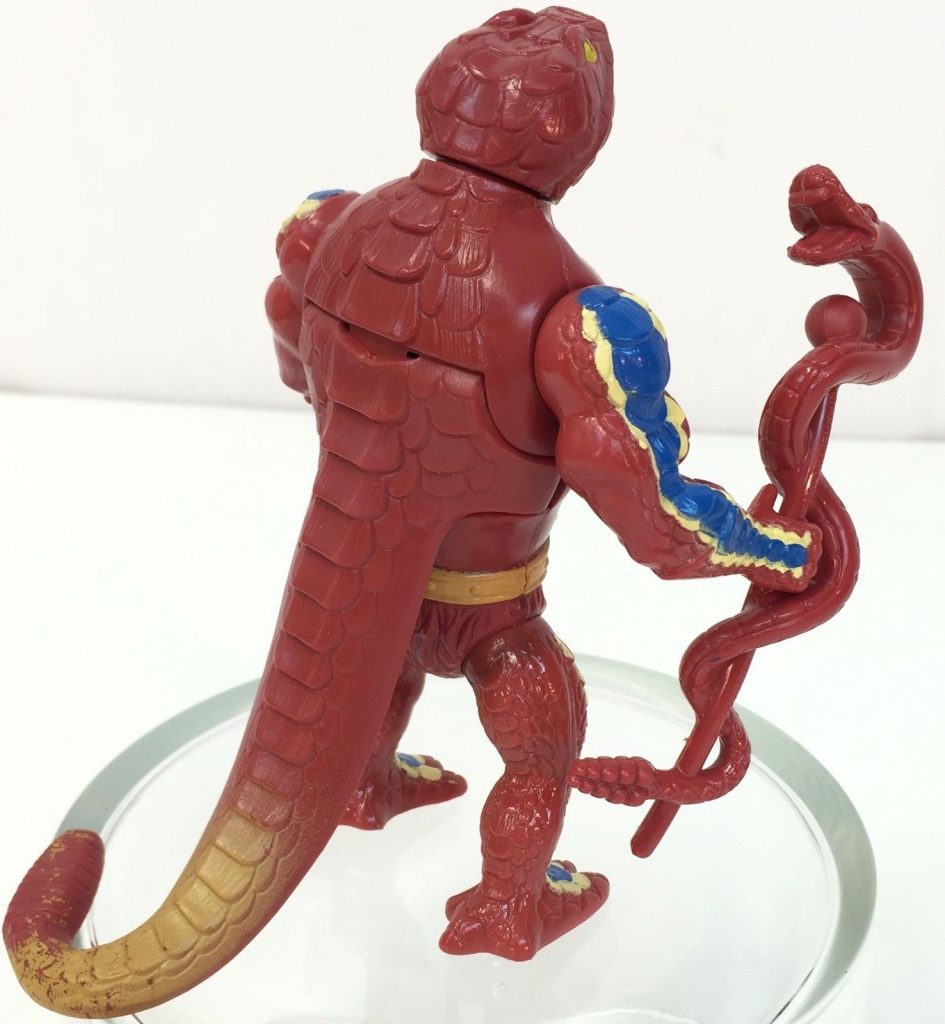
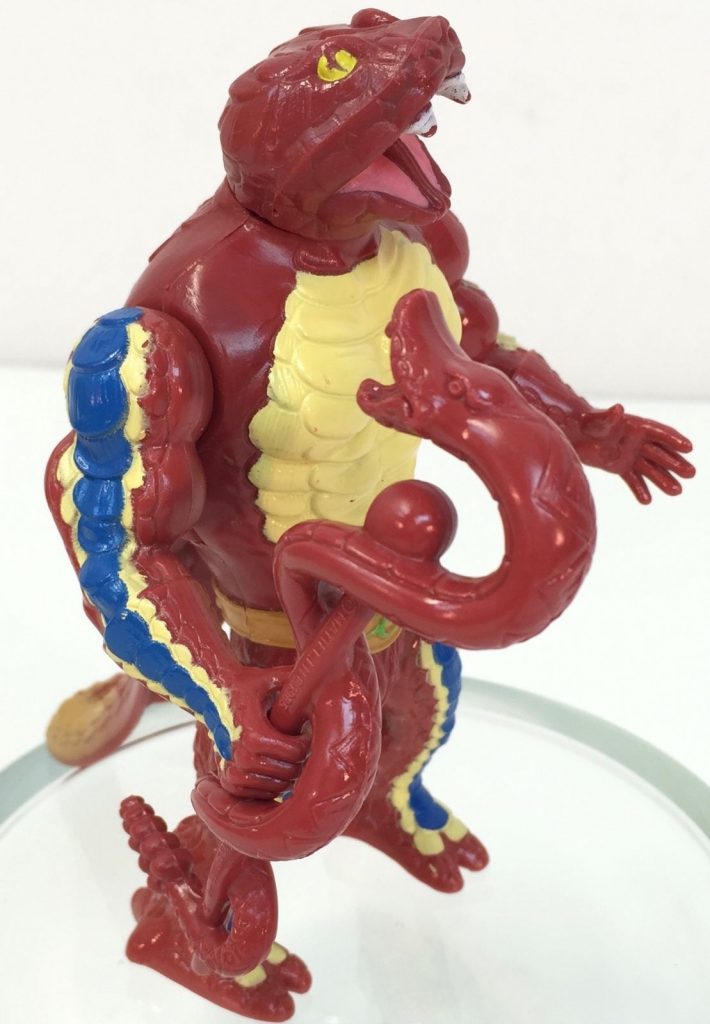


Rattlor’s quick-strike action feature was activated by pushing a button on the back of his belt, revealing a long yellow (or sometimes red) neck. There were also some loose bits of plastic in the figure, so that when you shake him you hear a rattling sound.

Packaging
The artwork on the back of Rattlor’s packaging was done by an unknown artist (Jukka Issakainen pointed out that it’s not Dave Stevens, as I originally thought – it’s signed either MT or TM). The name Rattlor was trademarked by Mattel on June 17, 1985, a year before the toy’s release.


Minicomics
As mentioned earlier, Rattlor’s design in most of his minicomics appearances represents an intermediate stage in his development, particularly in his first appearance in King of the Snake Men. His appearances in the last couple of minicomics of the toyline are much closer to his toy look. Throughout, he is described as a fairly typical muscle-headed henchman who rarely says much. In Snake Attack! Tung Lashor seems to be the brains, while Rattlor is the brawn. Rattlor also appears in The Ultimate Battle Ground, Revenge of the Snake Men, Energy Zoids, and The Powers of Grayskull.
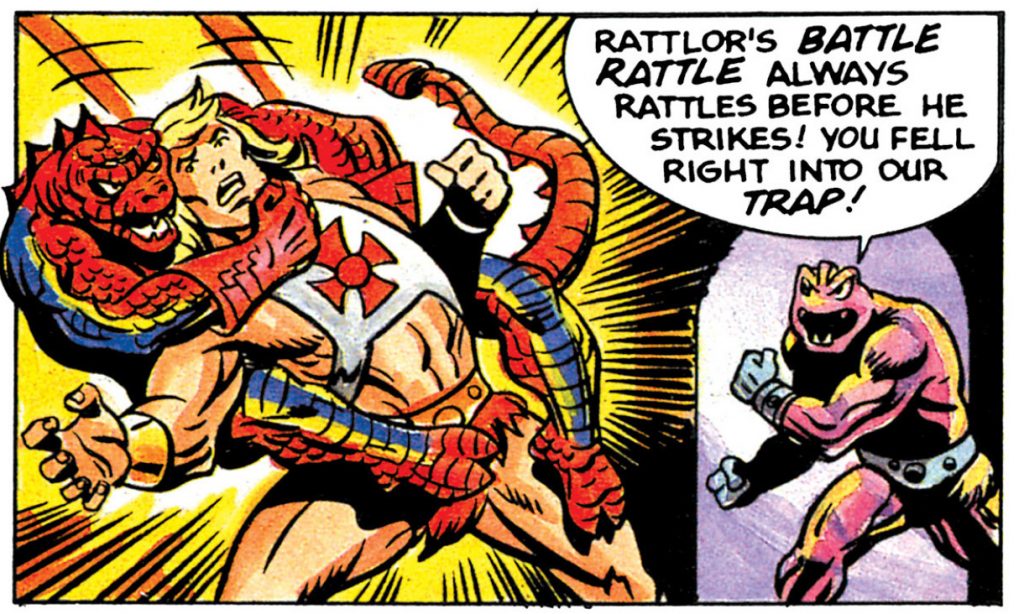
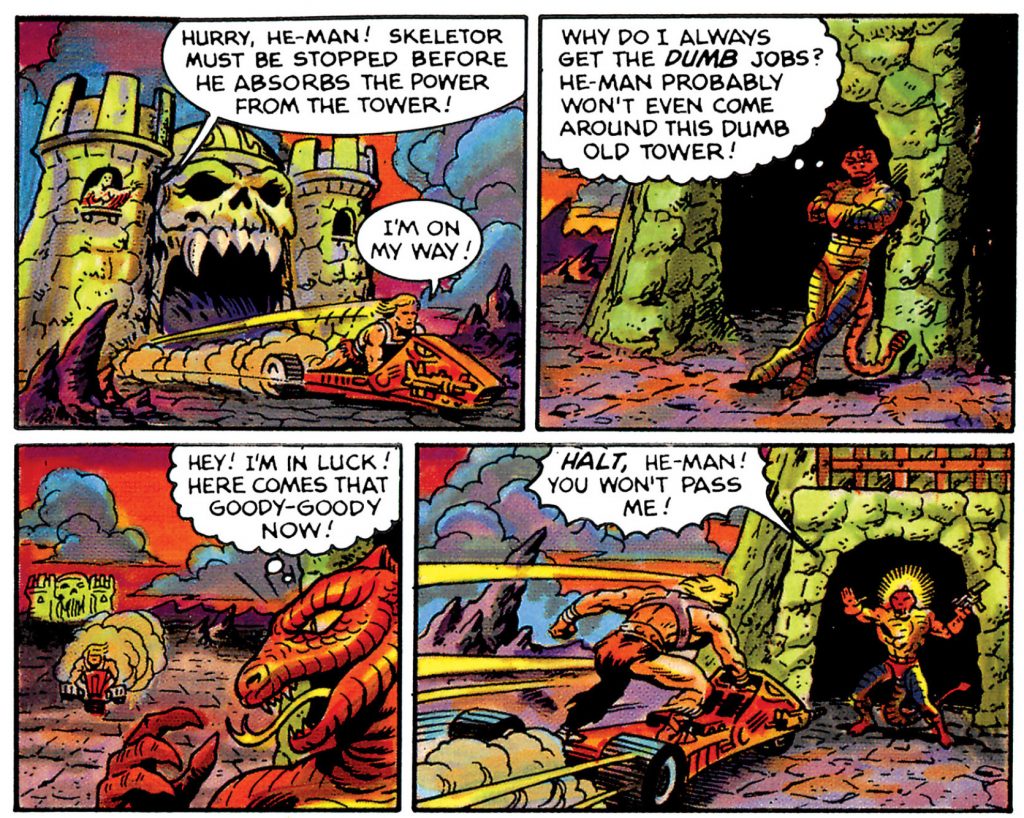
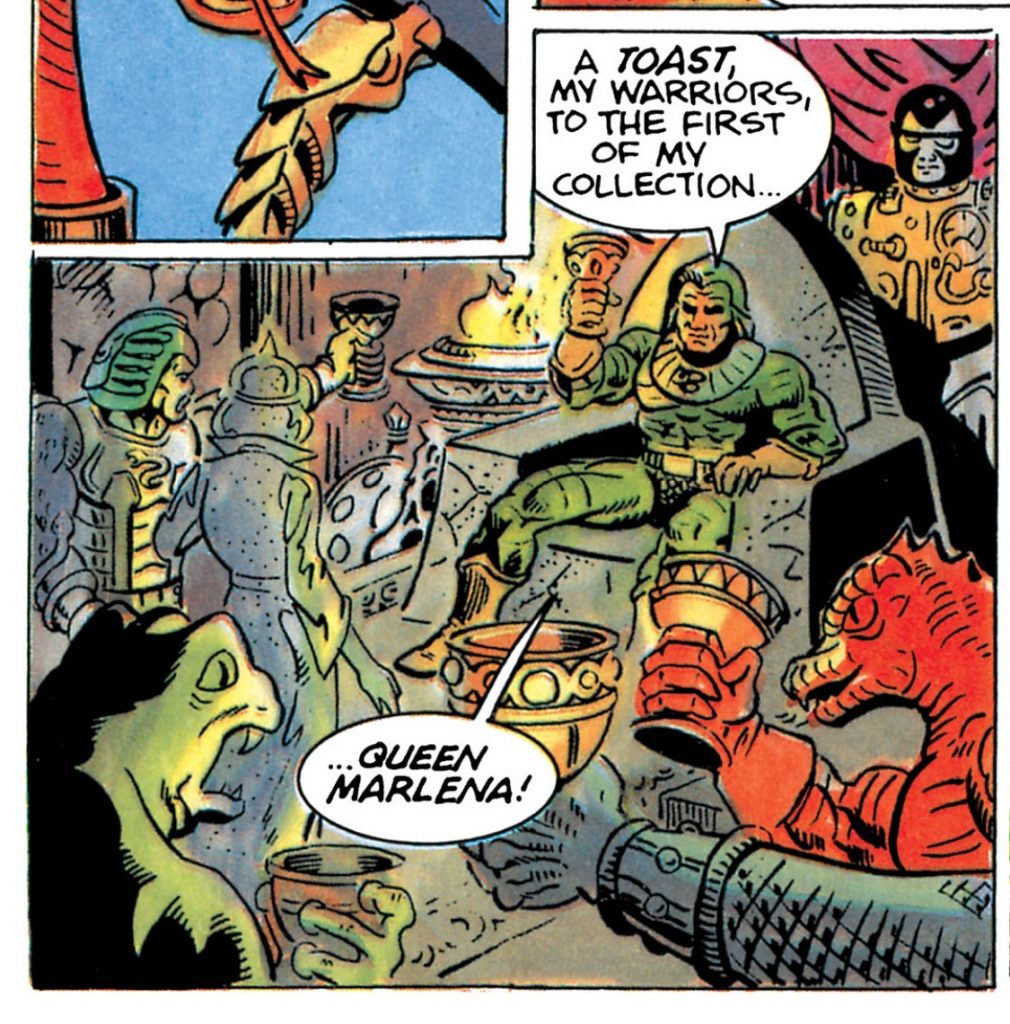

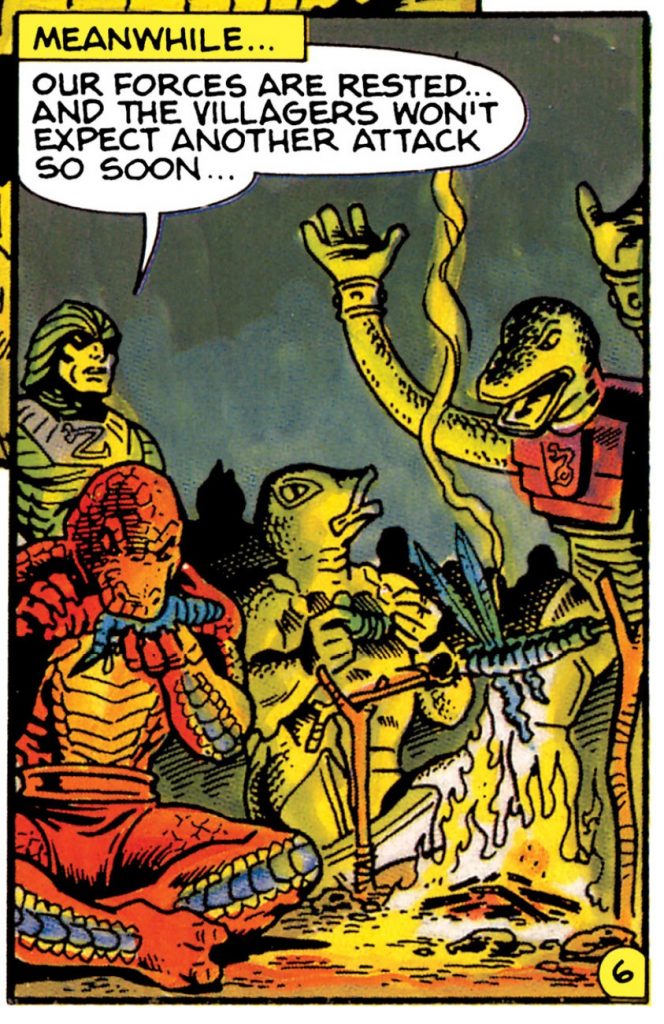
When Rattlor and Tung Lashor are introduced in King of the Snake Men, it’s mentioned that they had been serving Hordak before King Hiss summoned them. This is a reference to their appearances on the She-Ra cartoon series (they came out too late to appear in the original He-Man series, which ended in 1985).

Animation
In the She-Ra series, Rattlor is usually mute, although that’s not the case in the Christmas Special, where Rattlor gets a brief line. (There are other She-Ra episodes where he is given lines as well – see the comment from SpineBear at the end of this article.) Design-wise, Filmation’s Rattlor lacks the colored strips on his arms and legs, and he’s given purple trunks and a blue belt:


Before Filmation settled on the toy-like design for Rattlor, they were using a model sheet based on Roger Sweet’s original design:
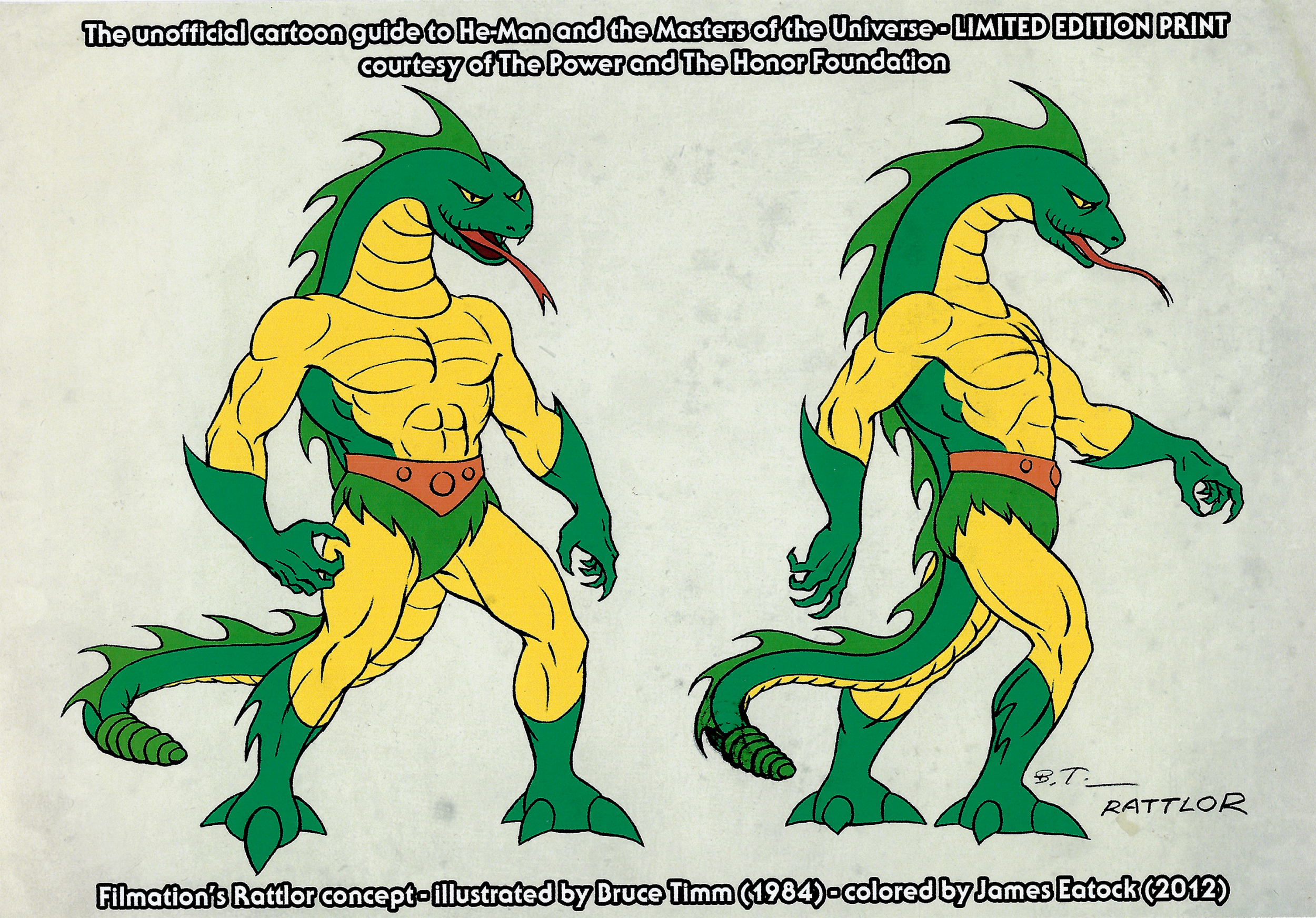
Stories, Comics & Magazines
In the 1986 Kid Stuff story book/record, Battle Under Snake Mountain, Rattlor seems to be more intelligent and talks more frequently than in other media, although he seems constantly terrified of King Hiss:


Both Rattlor and Tung Lashor are wildly off model in the 1987 UK MOTU Magazine story, “Attack of the Snakemen.” Tung Lashor especially looks unrecognizable and bizarre (I first learned about this issue from James Eatock’s excellent He-Man and She-Ra Blog).

In the MOTU newspaper story, Vengeance of the Viper King, Rattlor is also wildly off model, albeit based on line art from the Filmation She-Ra series. He appears here with green skin and no tail:


Rattlor appears in issue 7 of the US Masters of the Universe Magazine in The Armies of King Hiss:

Artwork Appearances
The same issue features one of Earl Norem’s most iconic MOTU paintings, featuring all of the snake men (including Kobra Khan, who had been retconned into that faction starting in 1986) that existed up to that point:
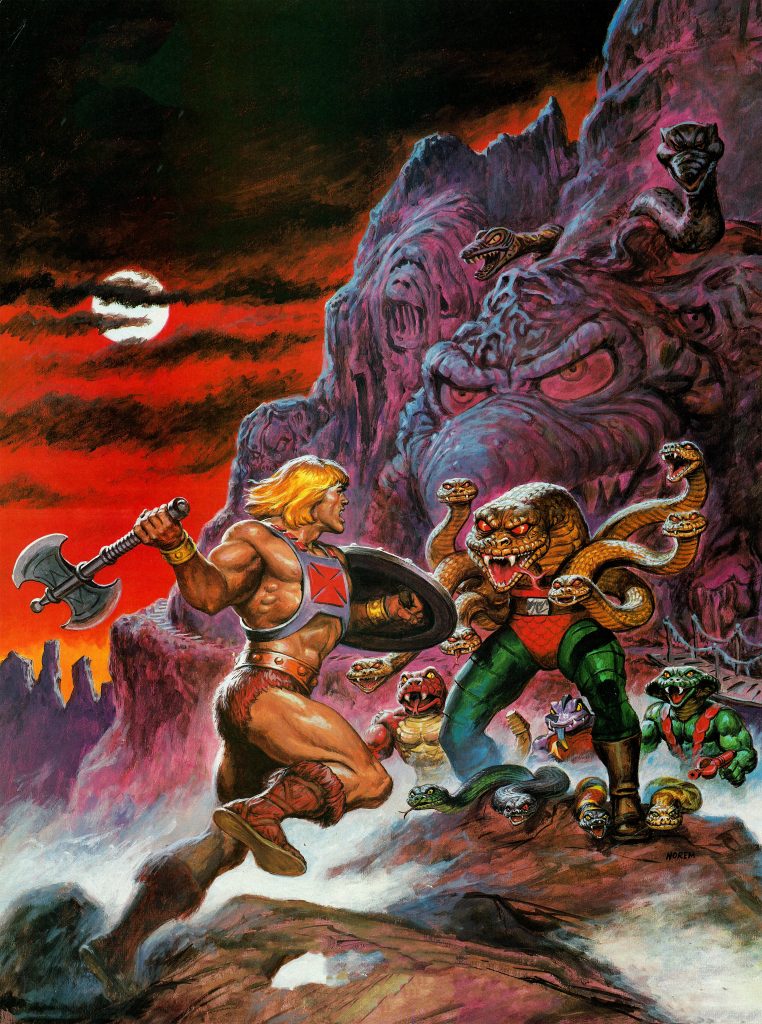
William George illustrated the character in both his Eternia playset boxart and in his Eternia poster:
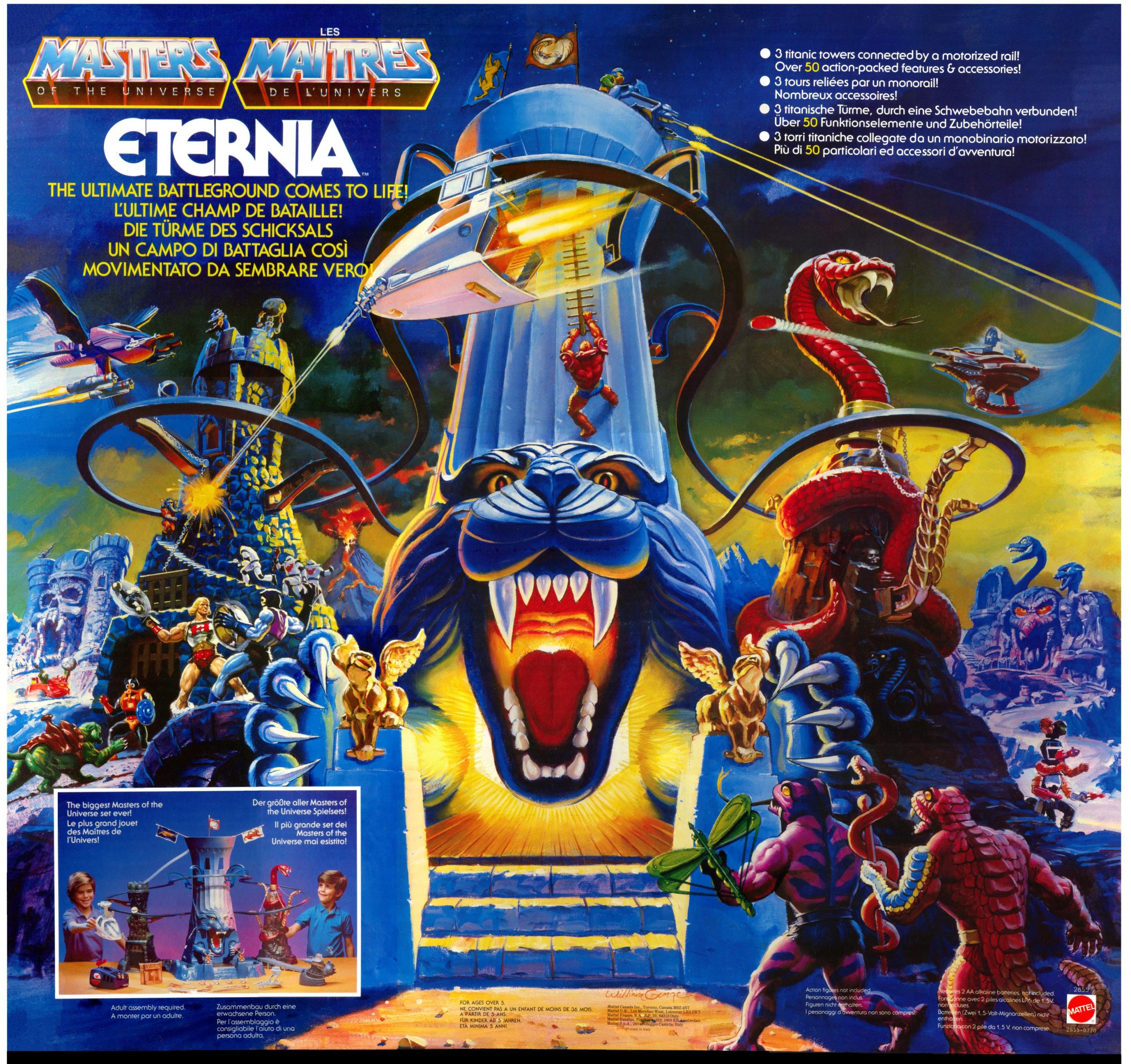
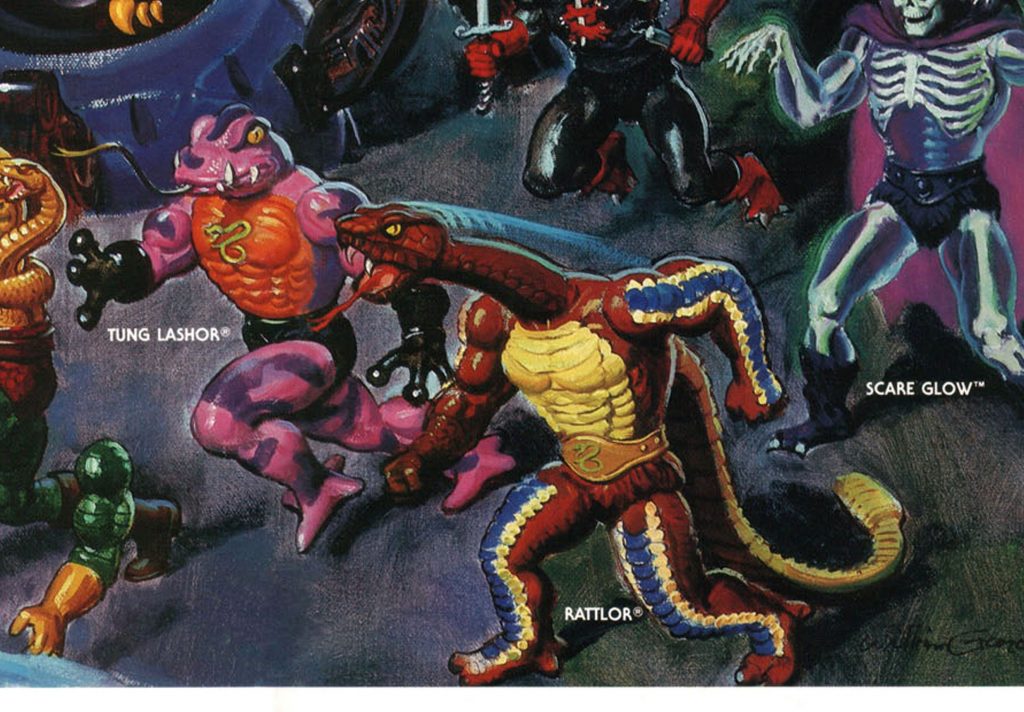
Artist Errol McCarthy drew Rattlor in a number of contexts, including in an illustration for the 1987 Style Guide:


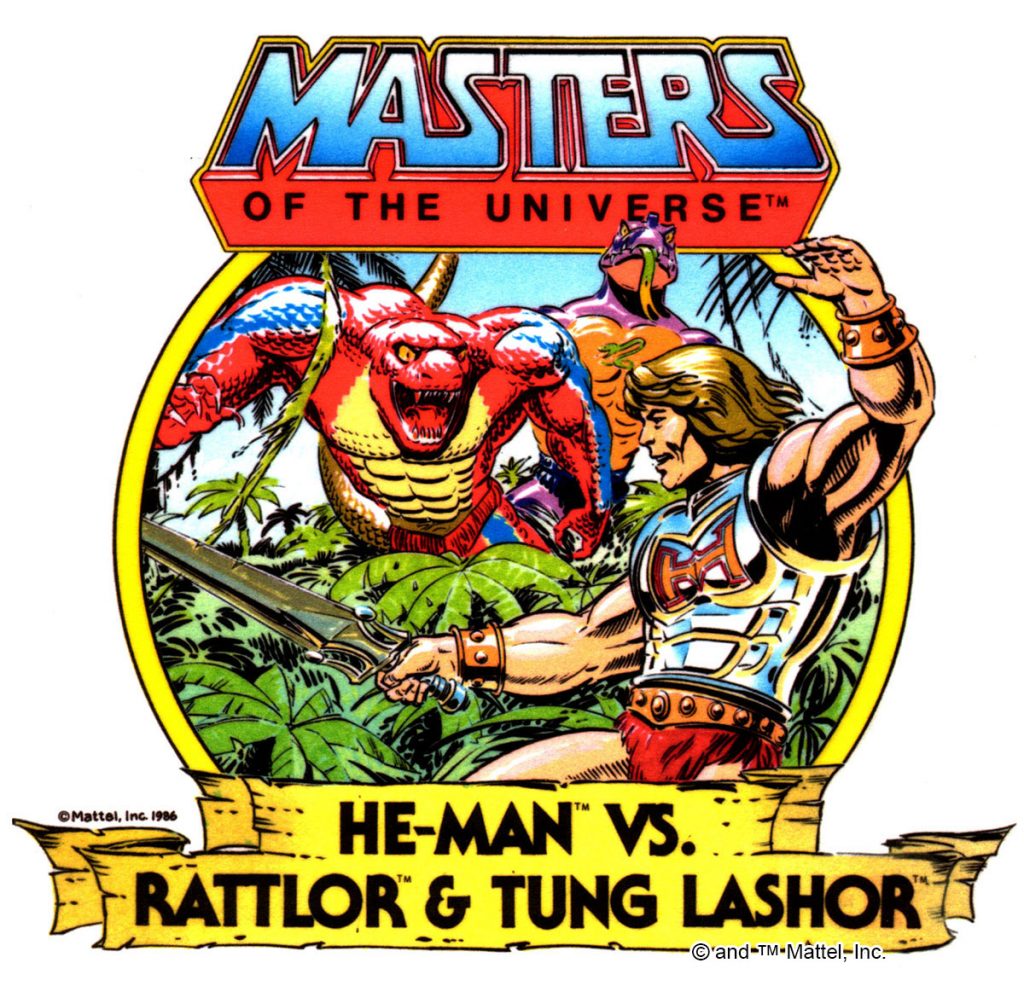
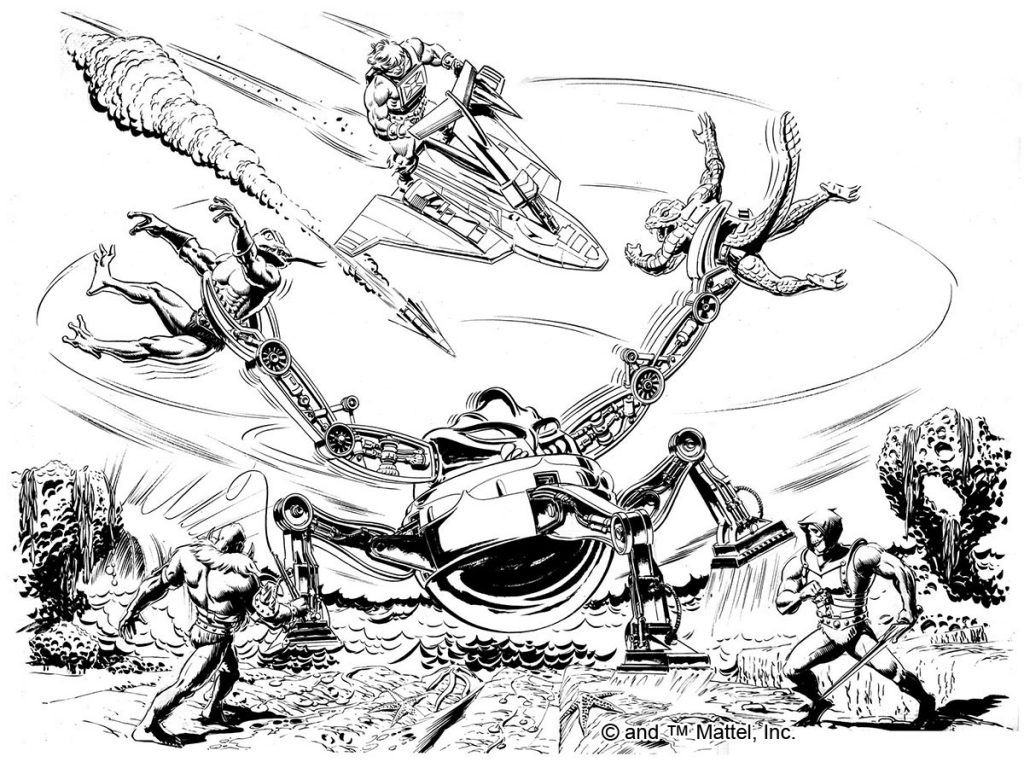
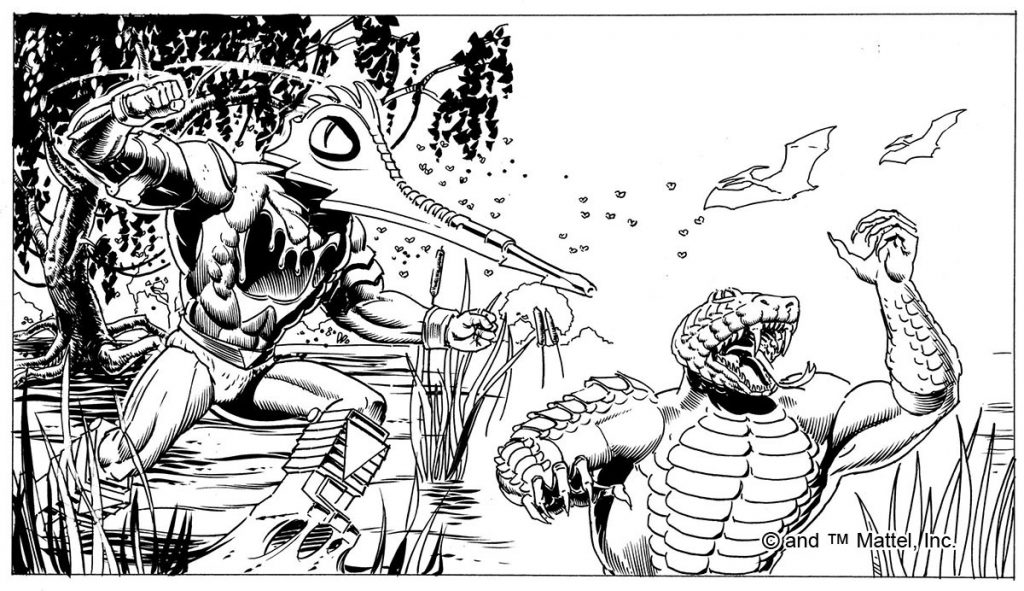
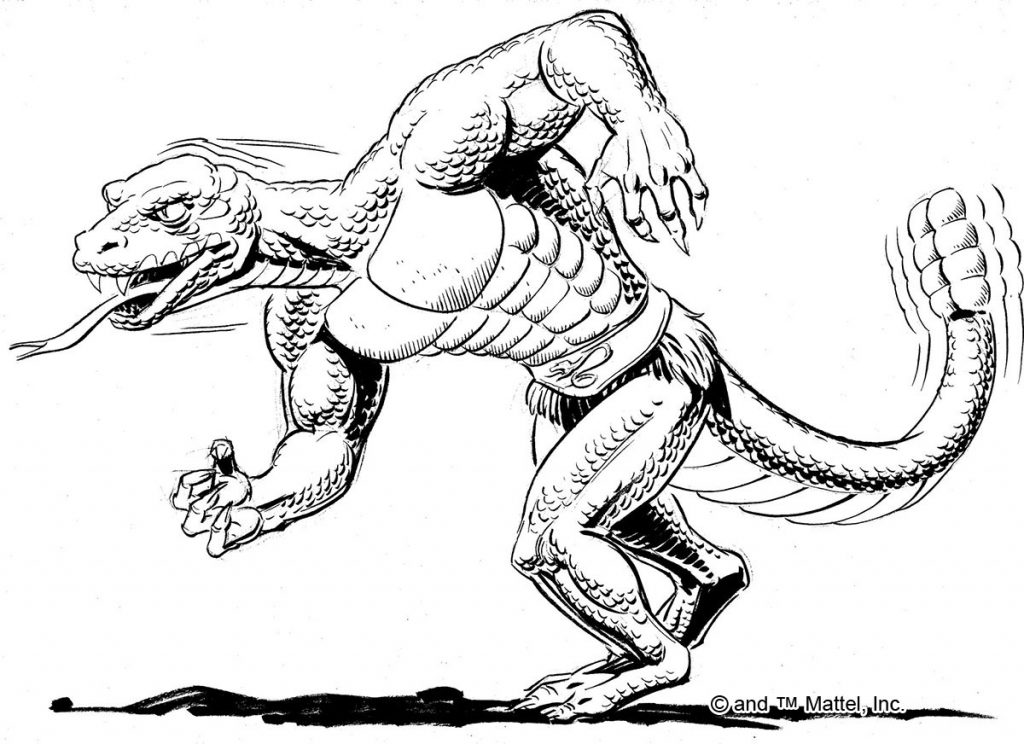
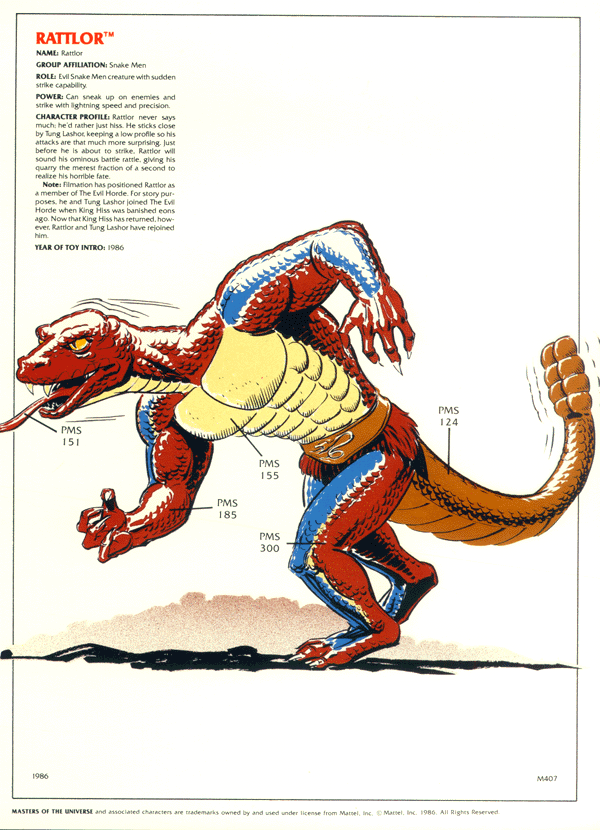
Characterization
The Style Guide characterizes Rattlor this way:
Power: Can sneak up on enemies and strike with lightning speed and precision.
Character Profile: Rattlor never says much: he’d rather just hiss. He sticks close by Tung Lashor, keeping a low profile so his attacks are that much more surprising. Just before he is about to strike, Rattlor will sound his ominous battle rattle, giving his quarry the merest fraction of a second to realize his horrible fate.
Note: Filmation has positioned Rattlor as a member of The Evil Horde. For story purposes, he and Tung Lashor joined The Evil Horde when King Hiss was banished eons ago. Now that King Hiss has returned, however, Rattlor and Tung Lashor have rejoined him.
There was also a fact file on Rattlor in the 1989 UK MOTU Annual, which also says that Rattlor preferrs hissing to speaking:

Rattlor is my favorite of the snake men. I love his Southwestern-looking color scheme, his detailed scaly skin, and of course his action features. I would have preferred a unique weapon for him, but otherwise he’s one of my favorite figures to come out in the last years of the line.
